

We've built a roulette game app that teaches you everything you need to know about playing roulette. Roulette trainer by Bojoko features:
You can read more about roulette as a game or jump directly to downloading the app.
There are hundreds of roulette guides available online. However, most of them are written by SEO copywriters instead of industry veterans. As a result, they only scratch the surface.
Our roulette guide is the only one you'll need to read. We know what we're talking about and cover every topic related to roulette, using:
After reading this guide, you'll be ready to hit the real roulette tables.
Click on the tiles below to get started.
Roulette is a classic game with straightforward rules. In this section, we cover the basics, take a look at the roulette table and walk you through an example round.
Roulette is a game of chance played against the casino.
The game consists of three main elements:
The roulette wheel features numbers from 0 to 36 and the table has corresponding betting areas. You place bets trying to guess which number comes up next.
The dealer spins the wheel and launches the roulette ball in the opposite direction.
When the ball slows down, it will eventually stop on one of the numbers.
That number is the winner. If you've placed bets on that number or any combinations of which that number is a part of, you win.
Roulette is a game with fairly simple and straightforward rules:
You can either bet on individual numbers or different sets of numbers.
Bets have different payouts, depending on how many numbers the bet covers.
You can place several bets on a single round.
We cover the exact payouts for different bets in the section Roulette payouts.
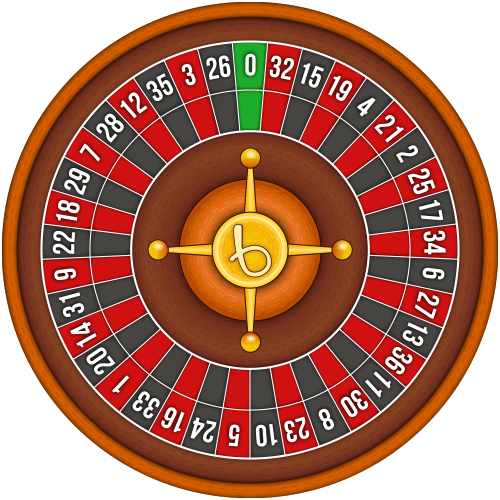
The roulette wheel features numbers from 0 to 36.
The zero slot is green and every other number on the wheel is either red or black.
The number of zeros on the wheel varies between different roulette versions. European roulette with a single-zero layout is the most common at online casinos, and we use it in our examples throughout this guide.
Numbers on the roulette wheel aren't consecutive. Here's the number sequence in clockwise order, starting from zero.
The roulette table is where you place your bets. The table has numbers from 0 to 36. The table consists of three betting areas:
In the next chapter, we'll look at these bets in more detail.
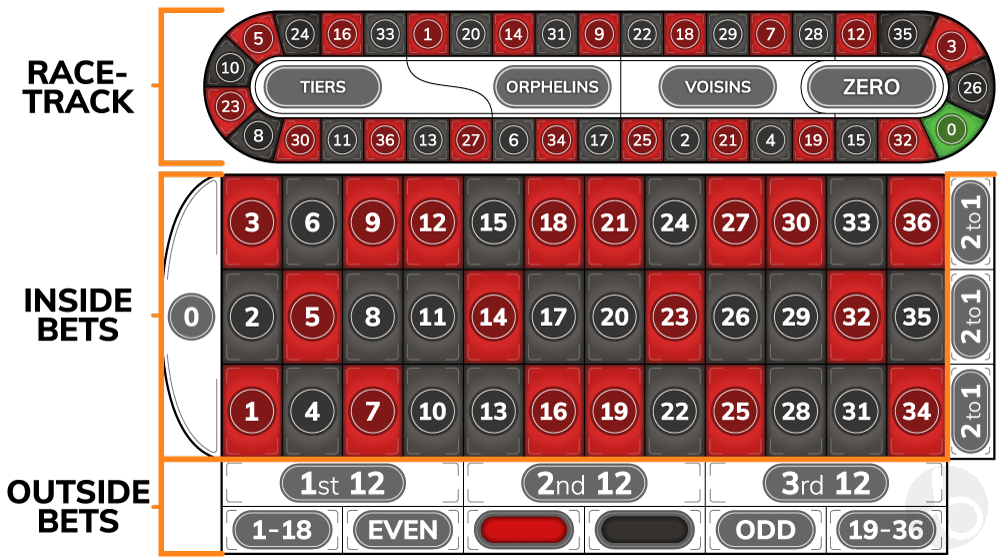
There are dozens of different bets in roulette. In this section, we cover all roulette bets, how they work and how much they pay. In addition, we take a look at the house edge.
There are many different types of bets available in roulette. The bets are divided into inside bets and outside bets, depending on the physical location of the chip on the table.
In addition, you can place bets on the racetrack section. There, the numbers are in the same order as they appear on the roulette wheel.
Payouts for roulette bets depend on how many numbers that bet covers.
EXAMPLE: You bet 1 chips on Black and win 1:1. You get 2 chips in total: 1 chip in winnings and your original bet of 1 chip.
1:1 bets are also known as even money bets: your potential win equals the sum you're risking.
Below, we list the payouts for all roulette bets and explain the bet types in more detail. Skip ahead to read more about roulette odds.
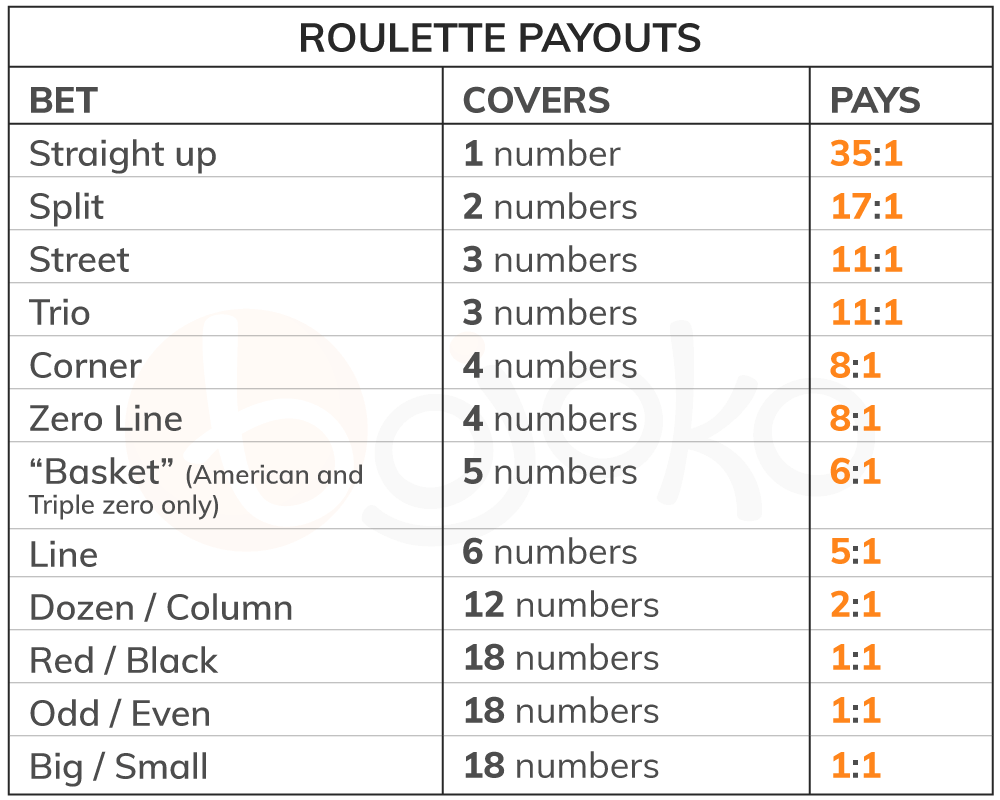
All the bets placed inside the numbered grid are called inside bets. In addition to the straight up bet on a single number, there are several ways to bet on adjacent numbers within the grid.
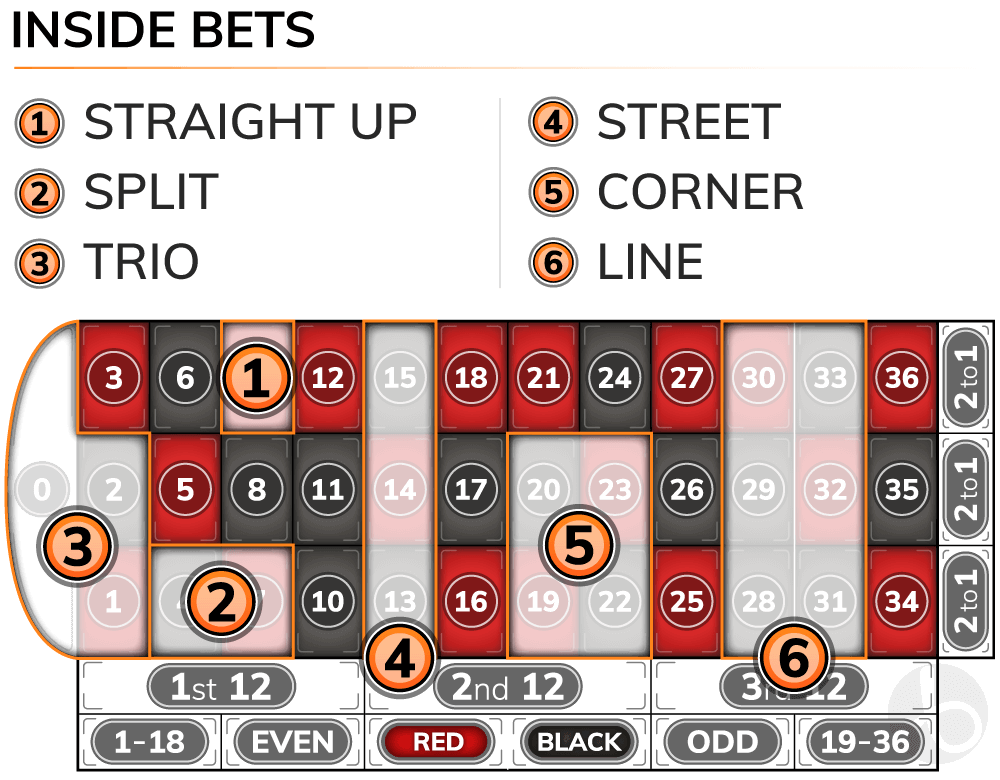
Outside the numbered grid, there are betting areas for different groups of numbers. There are several different outside bets, and they come in pairs and threes:
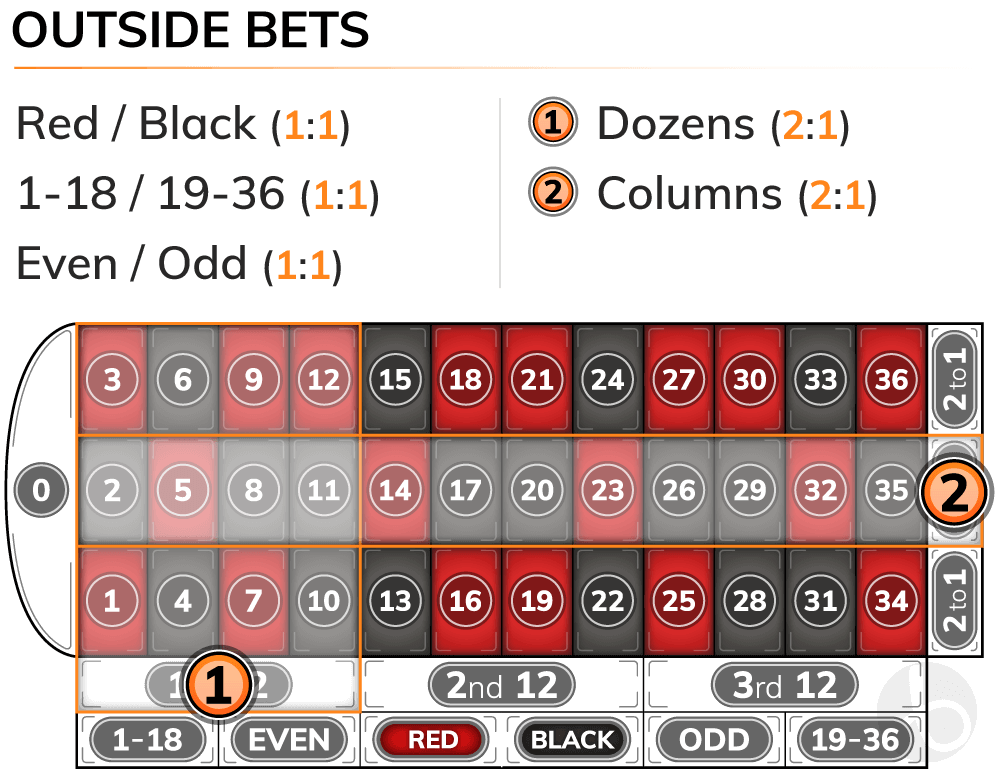
Zero is neither black nor white, big or small, odd or even. Neither is it part of any dozens or columns.
Unless you have placed a bet especially on the zero, you lose.
NOTE: French roulette has an exception to this rule, called La Partage.
The American roulette wheel has two slots for zero: 0 and 00. Thus, the American version has a higher house edge.
The race track is an ellipse-shaped area on the table. It features all the numbers in the order they appear on the wheel.
All tables don't have a racetrack. In some online roulette versions, you'll need to click on the "show racetrack" icon or select it from the menu.
Neighbours: At online casinos, you can use - / + buttons to select how many adjacent numbers of the racetrack a chip is placed on. If you select 0, you only bet on single numbers.
The race track is divided into 4 sections with French names. They are classic announced bets. Each has a specific way the bet should be laid out on the table. Since some bets feature a mix of singles, splits, trios and corners, the payouts vary between different numbers included in each group.
The term "announced bets" means that you have to say your bet out loud to the dealer. The dealer has to repeat your bet to acknowledge it. Announced bets are courtesy bets. Especially if the table is busy, the dealer won't always accept them.
In online roulette featuring the racetrack, placing announced bets is even easier: click on the bet name and the chips will be placed correctly.
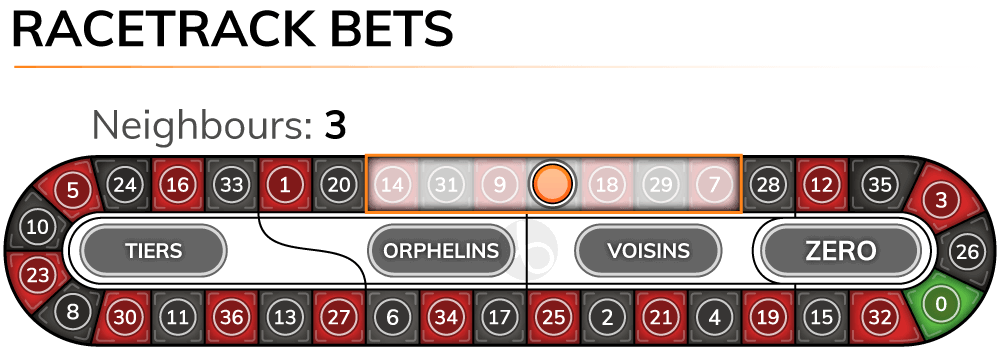
The zero bet covers 0 and the 6 surrounding numbers: 12, 35, 3, 26, 0, 32 and 15. It takes 4 chips to make this bet:
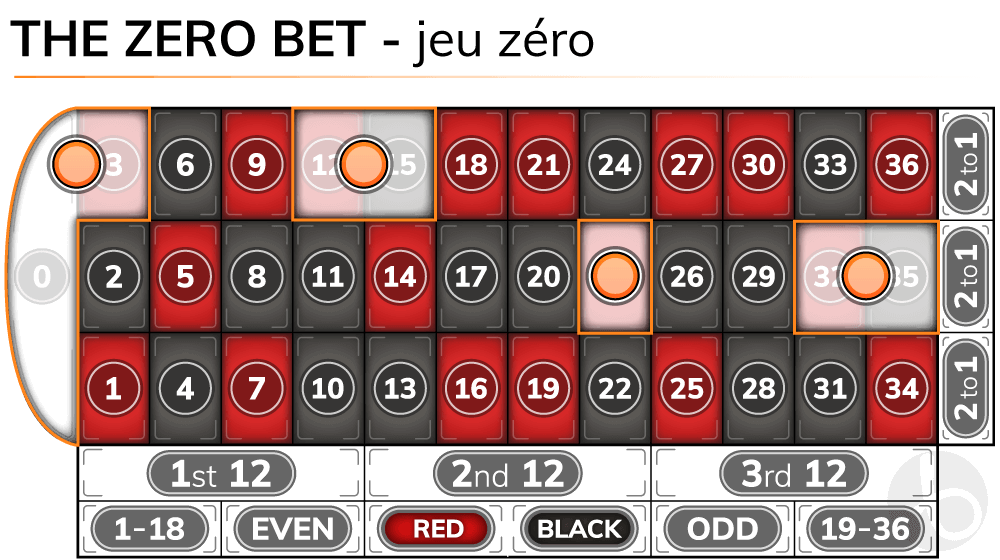
The neighbours bet includes all the numbers of the zero bet, plus 5 more numbers on each side: 22, 18, 29, 7, 28, 12, 35, 3, 26, 0, 32, 15, 19, 4, 21, 2 and 25.
Also known as series 0/2/3, you'll need 9 chips to cover all the neighbors of zero:

The thirds of the wheel bet covers 12 numbers opposite zero: 27, 13, 36, 11, 30, 8, 23, 10, 5, 24, 16 and 33.
Also known as series 5/8, it takes 6 chips to complete the tiers bet:
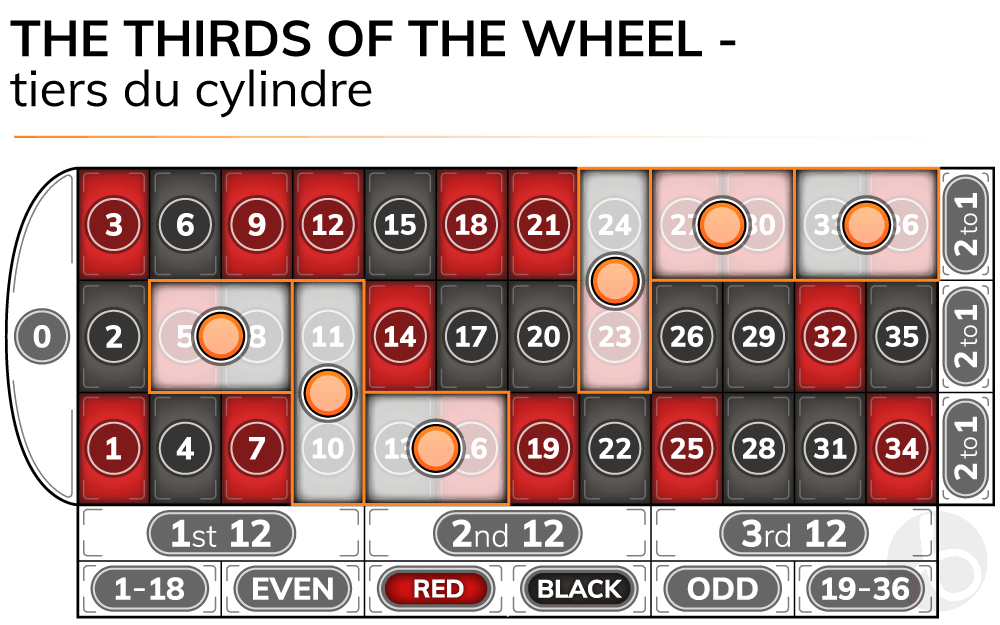
The orphans bet covers the 9 numbers not included in voisins and tiers bets: 1, 20, 14, 31, 9, 6, 34 and 17.
Because the numbers are situated on opposite sides of the wheel, this bet is also known as orphelins à cheval, literally "orphans astride". You'll need 5 chips for the orphelins bet:

Every bet in roulette has different odds for winnings. The roulette payout table represents the odds if there would be only 36 numbers on the wheel, without a zero or a house edge. However, most versions feature at least one zero. That's why the odds aren't so straightforward.
EXAMPLE: You bet on Black and the potential payout is 1:1. There are 18 black numbers and 19 non-black numbers (18 reds + 1 zero). The odds for winning your bet are 18:19.
In roulette, the odds are slightly in favour of the house. But by how much? By that zero.
House edge is the share of those bets that you'll be expected to lose.
In roulette, the zero forms the house edge. In single zero roulette, the house edge is 1/37 or 2.70%.
The house edge goes hand in hand with the Return to Player (RTP).
RTP tells you the percentage of bets you can expect to collect as winnings in the long term. In single zero roulette, the RTP is 97.30%.
EXAMPLE: You bet £100 on European roulette with the RTP of 97.30%. On average, you'll win back £97.30.
However, these are only averages and your mileage may vary. The results of a single roulette session aren't a big sample. Instead of getting back exactly 97.30% of the money you place on the table, you may lose it all, win it back 100-fold or something in between.
Whether you play online or at brick-and-mortar casinos, every roulette table has minimum and maximum bets. These are known as table limits.
At the same table, the limits may be different for outside and inside bets.
At brick-and-mortar casinos, outside bets have a higher minimum and maximum limit than the inside bets. Depending on the casino you visit and the table you choose, you may see e.g. a £1 minimum for inside bets and a £10 minimum for outside bets.
The table maximum typically ranges between 50 - 500 times the minimum bet.
At online casinos, the table minimum is usually the same for all bets. However, in live dealer roulette, table maximums may be lower for inside bets than the outside bets.
This encourages placing bets with higher hit frequency but lower payouts, resulting in more predictable results for both players and casinos.
There are several different versions of roulette available both online and offline. Although the basic idea stays the same, each variant has its own twist. In this section, we go through different roulette versions and their pros and cons.
The roulette versions differ slightly from each other. The most notable differences are:
European roulette has become the standard version at most online casinos. Outside the United States, it's also the most popular roulette variant at brick-and-mortar casinos.
Here are the key specs for European roulette:
Pros:
Cons:
If you're focused on the small house edge, French roulette is objectively the best roulette version out there.
Pros:
Cons:
French roulette is almost exactly the same as European roulette. The only material difference is the La partage rule.
In addition, the French versions often use a slightly different table layout. In the French layout, outside bets are spread on both sides of the numbered grid.

EXAMPLE: You bet 2 chips on Red and the ball stops on 0. In French roulette, you get back 1 chip.
Because of the la partage rule, French roulette has a lower house edge than most other versions. The return to player percentage is 98.65% for 1:1 bets and 97.30% for other bets.
La partage is French and means sharing. Some French roulette tables also use a variant of this rule called En prison (in prison).
When the ball stops on zero, your stake for a 1:1 bet is left on the table and the dealer places a marker on it to signify it is "en prison". If your en prison bet wins on the next spin, it is returned to you.
EXAMPLE: You bet 10 chips on black. The ball stops on 0. Your stake stays on the table with an en prison marker. On the next spin, the ball stops on black. You get back your original stake.
If there is another zero, the house rules vary. Your en prison bet may be treated either as won, lost, la partage or en prison.
In the long term, en prison rule offers the same return to player rate as la partage. The odds for winning on the spin after the zero are 1:1 if another zero results in either la partage or another en prison round. On average, you'll win half of those bets, meaning you'll get back half your stake.
From the casino's perspective, both versions have their drawbacks:
At both online and offline casinos, la partage is the most common way to resolve zero in French roulette.
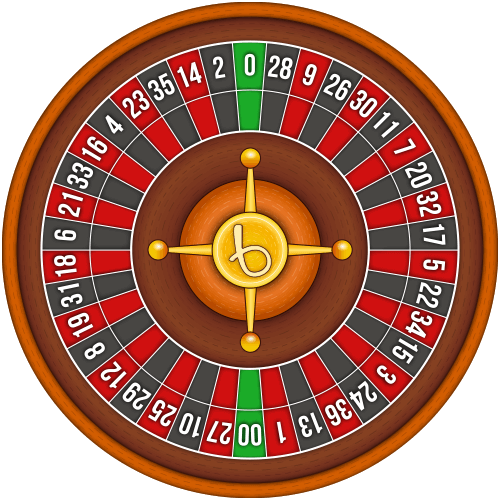
American roulette is the prevalent roulette version in the United States.
Pros:
Cons:
American roulette is slightly different from its European counterpart. The wheel has two slots for zero: 0 & 00.
Because of the two zero slots, the American roulette wheel has a different number sequence than the European version:
Since the zero forms the house edge in roulette, the American version is almost twice as profitable to the casino. At 5.26%, American roulette has a higher house edge than most other variants.
However, many casinos make it more appealing by offering lower table limits for American roulette. At the same time, they reserve the better RTP European version for clients with deeper pockets.
Outside the US, American roulette is popular at brick-and-mortar casinos with mainly American clientele. For example, the Bojoko team only saw American roulette at the resort casinos of the Dominican Republic.

TIP 1: The worst bet in American roulette is the zero line bet, a.k.a. "the basket." It covers 5 numbers: 0, 00, 1, 2 and 3. With a payout of 6:1, the house edge for this bet is a whopping 7.89%.
TIP 2: Atlantic City casinos offer American Roulette with La partage rule. This brings the house edge to 2.63% for 1:1 bets.
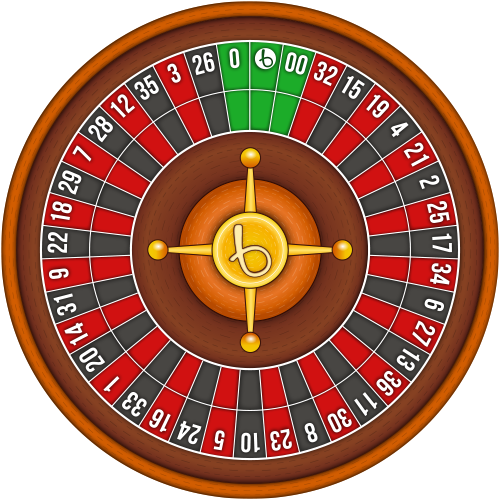
Triple zero roulette is a recent addition in Las Vegas casinos. Instead of settling for the already big house edge of 5.26% in American roulette, they have introduced a wheel with 3 zeros. This brings the house edge to an extortionate 7.69%.
Pros:
Cons:
The triple zero wheel has sometimes been spotted at charity gambling events. The additional zero helps tilt the odds in the favour of the organiser and raise money faster.
In 2016, though, the triple zero wheel made its commercial debut when The Venetian in Las Vegas introduced the Sands Roulette. Others quickly followed suit. You can now find the triple zero wheel at many renowned Vegas strip casinos, including Excalibur, MGM Grand and Planet Hollywood.
Layout-wise, the triple zero roulette is a combination of the European and American. The wheel sequence is similar to the European version, with the two extra zero slots clumped together with the single zero:
The exact order of the zeros varies, and the triple zero may carry a casino or game logo instead of reading 000.
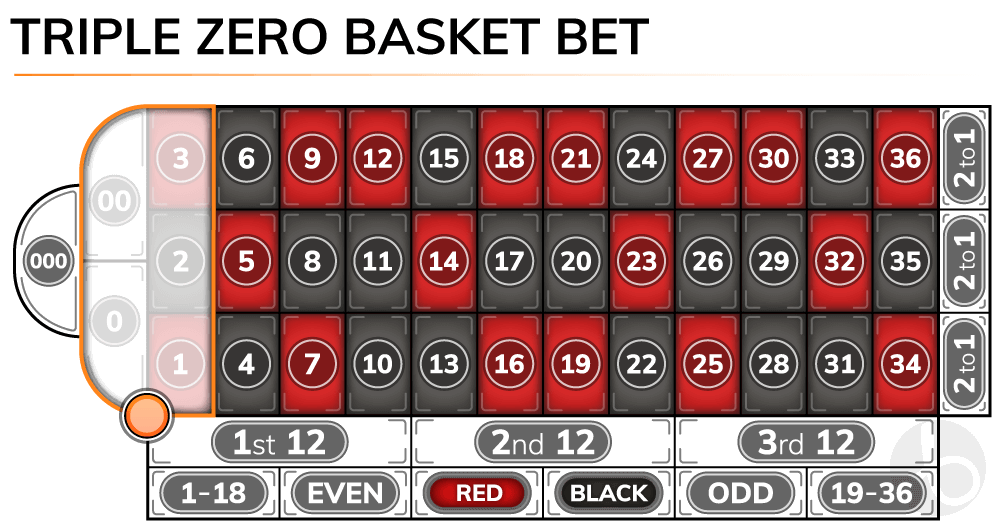
However, the triple zero roulette table incorporates the worst feature of American roulette. Instead of laying the zero betting areas in a single row, the table features the familiar 5 number zero line bet (basket bet). This time, though, the house edge is even higher: 10.26%.
No zero roulette is an extremely rare sight at online casinos and non-existent at brick-and-mortar establishments. Although the game itself doesn't have a house edge, the casino deducts 10% from your net winnings as commission.
Pros:
Cons:
No zero roulette is an equal odds game. Neither the wheel nor the table has a zero, so there's no house edge in the game itself.
EXAMPLE: You bet on black. Without the zero, the odds of winning are exactly 1:1, instead of the usual 18:19.
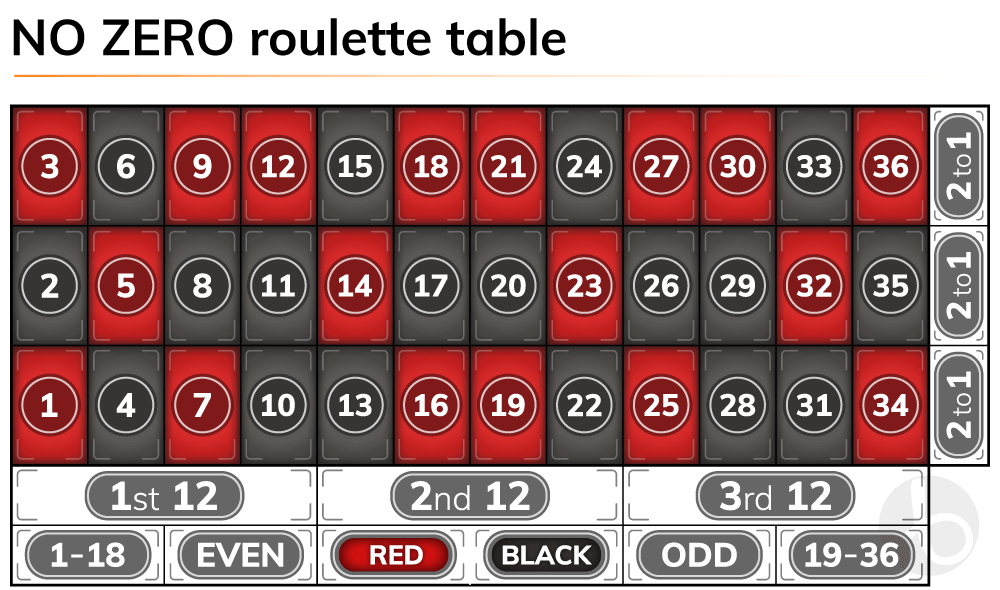
However, casinos don't run games out of charity. Even though there isn't a house edge in the game, the casino takes a 10% cut of your net winnings. This is known as the commission.
The commission is taken only from your net winnings. If you lose or break even within the session, you won't be charged anything extra. If you win, however, a whopping 10% of that extra moolah is lost.
10% commission is not a small one. As the math shows, the commission brings the house edge to 5%, making the no zero roulette almost as bad as American roulette.
MATH:
Double ball roulette mixes up the traditional roulette payouts and odds. There are two balls in play, and some bets require both of them to land your way to score a win.
There are a few different versions of double ball roulette available. The payouts and the table setup used differ between land-based and online casinos.
As a rule of thumb, online versions use the European single zero wheel and more generous payouts. Brick-and-mortar casinos (especially in the US) tend to use the American wheel and lower payouts.
The exact return to player percentage depends on the rules and table used. In the most popular online version, Evolution Gaming's Double Ball Roulette, the RTP is 97.30%, the same as in European roulette. For the payouts quoted below, we use the Evolution version as an example.
Pros:
Cons:
Double ball roulette has two types of bets:
In many versions, these bets have distinct colours so you can tell which is which. For example, in Evolution Gaming's Double Ball Roulette, bets where both balls must land are marked with gold.
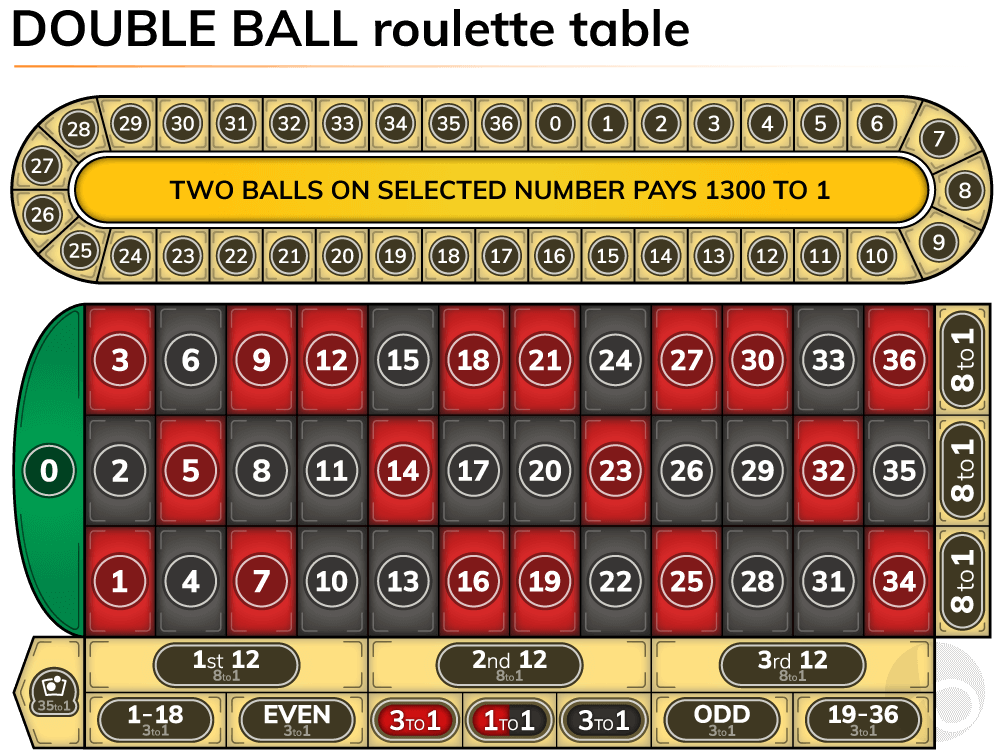
In double ball roulette, there are also two different betting areas for single numbers, i.e. straight bets.
Below, you can find the double ball roulette payouts, as they're listed in Evolution Gaming's version:
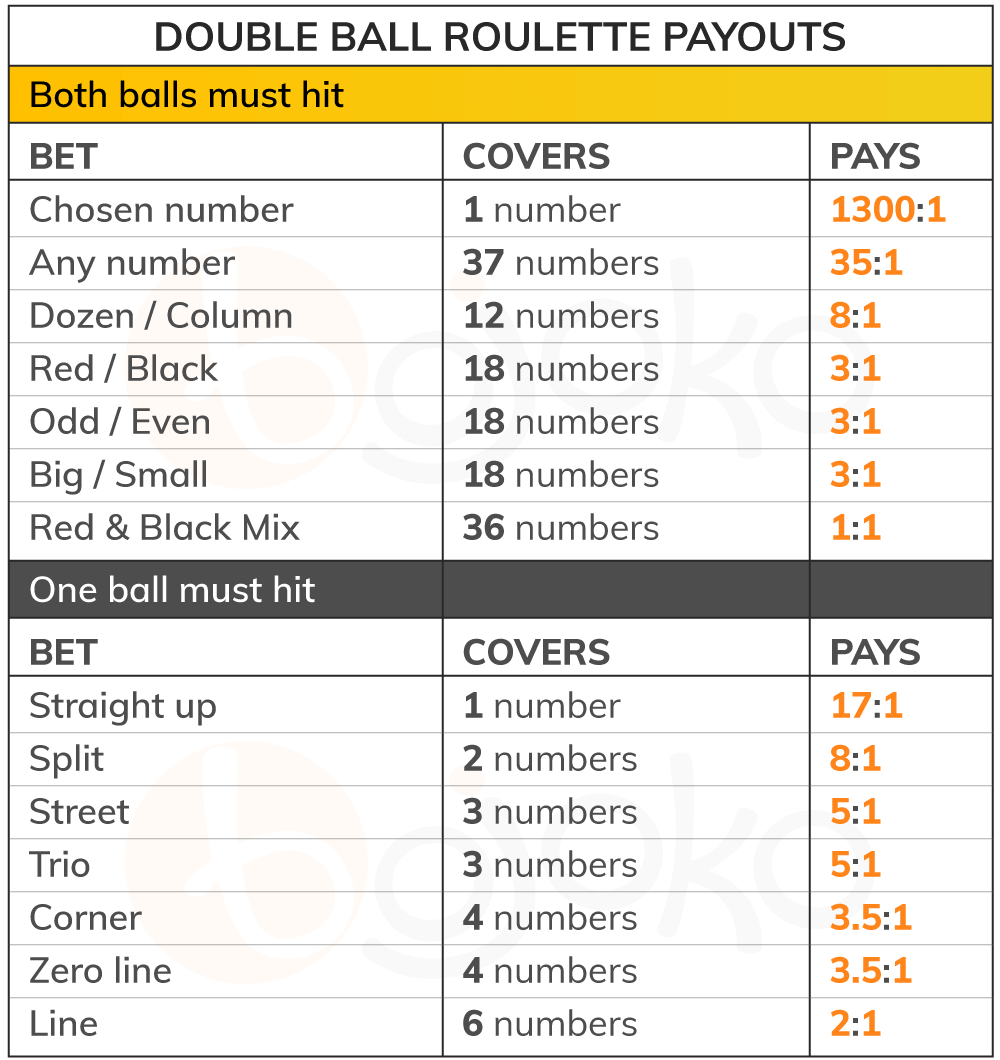
Make a note of the payouts for Red, Black and Mix. If both balls land on the same colour, the payout is 3:1. However, the payout for the mixed bet of Red AND Black is only 1:1.
One would think that it's 2:1 for both colours and the mix, but when you work out the math, it actually makes sense.
For a single ball, the odds for landing on either Red or Black are roughly 1:1 (excluding the zero). If we bring in the second ball, the results are divided thus:
Lightning Roulette is one of the proprietary games of Evolution Gaming. This roulette version gives an extra incentive to bet on the single numbers.
Every round, the lightning strikes on up to 5 numbers and raises their multiplier up to 500x your original bet. However, the unaffected numbers only pay 30:1.
Pros:
Cons:
Lightning Roulette is set in a stylish art deco studio, dominated by a big screen and an illuminated roulette wheel. After the bets are placed, it's time for the Lightning Round.
The system randomly selects between 1 and 5 lightning numbers that get a boosted multiplier. The multiplier varies between 50 and 500, and depends on how many numbers become lightning numbers.
If the ball lands on a lightning number, all straight bets placed on that number payout according to the boosted multiplier. If it lands on a non-lightning number, the payout is 30:1.
The lightning multiplier only affects straight bets on single numbers. Splits, streets, corners etc. pay out at a normal rate.
Lightning Roulette is available at most live dealer casinos featuring Evolution's table games. In 2019, the company also released a version called First Person Lightning Roulette. This variant is exactly the same game but without the live dealer. The atmosphere isn't quite there, though. Luckily, there's a big "GO LIVE" button next to the chips.
Mini roulette is arguably the worst roulette version available. Featuring numbers from 0 to 12, the odds of hitting a zero and losing any other bets are quite high.
Mini roulette is marketed as a beginner-friendly option and as a roulette version that you can play on the corner of your screen while placing bets on another game in your main window. Although we can't argue with the simplicity, the horrendous RTP should turn any discerning gambler away from mini roulette.
Some mini roulette versions feature the la partage rule, though. If the ball lands on zero, you get back half your stake for even money bets, i.e. Red / Black and Even /Odd. This raises the RTP from 92.31% to a respectable 97.44%.
With the la partage rule in place, mini roulette is actually worth playing. Without it, we recommend skipping it.
Earlier, mini roulette could be found at several online casinos, but we haven't spotted it on our favourite sites recently. Some land-based gaming terminals around the world still feature mini roulette, though.
Pros:
Cons:
Online roulette has become a popular way to play this classic game. In this section, we explain the difference between live dealer and RNG roulette, look at different versions available, list best places to play and talk about roulette bonuses.
Many gamblers prefer online roulette over the brick and mortar version. Here are some of the main reasons why:
Free online roulette is a perfect way to get the hang of the game, try out betting systems and understand the rules before heading to the real tables.
Most casinos let you play roulette in demo mode for play money. However, UK players must first sign up and verify their account at the casino.
We've also built our very own tool, Roulette trainer by Bojoko. It's 100% free app and available for download for Android and iOS. The trainer includes the following features and modes:
Our roulette app is also available for download on Android and iOS:
We've also built a blackjack trainer for learning the rules and improving your skills.
Picking the best roulette sites is a matter of exact data and personal preference. When comparing the best online casinos to play roulette, we're looking at these factors especially:
To find such things out, we asked experienced players to test the casinos with real money and write an honest review. To be fair, roulette wasn't the only consideration for these reviews. However, most testers do give the wheel an occasional spin and report their experiences.
We've compiled the following list of the top 10 roulette sites for UK players. It's based on the casino tester reviews, our own experience and data listed by the casinos.
Playing roulette online is very easy. Here, we'll walk you through the entire process.
Pick a casino where to play roulette. There are some solid choices on the list above.
Read the review and the real experiences of our casino tester. Pay special attention to the Games section and remember to check the terms for a possible bonus. When you've made up your mind, click on the green PLAY HERE button to go to the casino.
Create an account. There should be a big button saying SIGN UP, REGISTER or something like that on the landing page. Clicking that, you'll get a sign-up form.
Fill in the details the casino asks during the registration. Use accurate info only and don't make stuff up. If you do, you may not see your money ever again. You may need to verify your email or phone number by clicking a link you get in your inbox.
Make a deposit. Depending on the casino, the deposit section has many ways to top up your account. Choose the one you're familiar with, pick a sum suiting your gambling budget and click on the deposit button.
Claim a bonus (optional). Some casinos also offer bonuses for roulette. More on that later. If you fancy a bonus, claim it now. Remember to check the terms, though.
Find the roulette games. You can find a variety of roulette games on practically every online casino site. Game menus differ, but logical places to start looking for are:
Pick a roulette version. There are random number generator (RNG) roulettes you can play at your own pace. Most casinos also feature a live dealer roulette section, where a real human croupier spins the wheel.
Play the game. Select the chip denomination, place your bets and spin the wheel. You can see exact payouts, table limits and more detailed rules on the info screen.
Withdraw your winnings. Find the withdrawals section and make a withdrawal request to collect your winnings. Processing your request may take anywhere between a few hours to several days. You'll find the quickest options on our fast payout casinos page.
Complete the KYC. Before the casino processes your withdrawal, you may need to complete a KYC (Know Your Customer) check. Just send over copies of any documents they ask fir in the specified format. These include:
Online casinos offer many ways to play roulette. However, you'll need to find the right sites if you want to try as many versions as possible.
At many online casinos, classic casino table games are an afterthought. They only feature a few versions of European and American roulette. This is enough for all players.
Luckily, there are sites that specialize in table games, roulette included. They offer many roulette variants from different game providers, both as RNG (Random Number Generator) or live dealer versions.
Below, we explain the difference between the two and list different roulette versions you can play online.
RNG or random number generator roulette is completely digital. The roulette table and the wheel of an RNG roulette are just digital images and animations. They help create an authentic gaming atmosphere and a familiar user experience.
Powered by a random number generator, the RNG roulette generates random, unpredictable results. This is even more random than a physical roulette wheel operated by a human dealer.
The random number generator is running all the time, even when nobody is playing the game. The algorithm determines the outcome of the round the moment you hit the spin button.
3D roulette isn't a separate roulette version as such. It's an RNG roulette with some 3D effects, namely a very pretty wheel.
At least Playtech has a version of 3D roulette.
Live dealer roulette brings the brick and mortar casino to your own screen. There's a real human dealer spinning the wheel, and possibly thousands of players around the world at the table with you. With the chat function, playing live dealer roulette can be a social experience.
Live dealer roulette is a game you can trust. Because the spin is exactly the same for all players, there's no way to rig the wheel to avoid your bets.
There are many different types of live dealer roulette available online. The selection at the casino depends on which live casino game suppliers they have decided to work with.
The biggest player in the live dealer casino market is currently Evolution. We cover this company and its competitors in more detail in the section Roulette game suppliers.
In addition to the live dealer roulette played in a studio with a real human dealer, there are also two variations:
Live auto roulette is a combination of RNG and live roulette. It's powered by a random number generator, but the results of each round are the same for every player around the world.
If you distrust the standard RNG roulette and suspect the software is designed to avoid your numbers especially, then this is the game for you. Since there are thousands of players at the table at any given time, the spin treats them all the same.
Auto roulette is also a budget-friendly solution. You can get started as low as 10p per spin, and raise your bet up to £10,000.
Dual play roulette combines the brick-and-mortar casino atmosphere with the convenience of online casinos.
Dual play roulette tables are normal roulette tables open to all players at the casino. They have cameras and sensors that enable you to watch the stream and place your bets together with the players at the casino.
The only drawback of such casino floor roulette is the pace. If the table is busy, the dealers will have their hands full with paying the winners and exchanging chips. This will result in some delay between the spins.
The leading dual play roulette provider is Authentic Gaming. However, Evolution also has some casino floor streams.
As we've discussed in the section Maximum and minimum bets, all roulette tables have table limits. Online versions are no exception.
However, at online roulette tables, you have a bigger range of bet sizes to choose from than at brick-and-mortar casinos. Whether you're a high roller or a budget-conscious player, online casinos have got you covered.
There are several high limit roulette options available at both the live dealer and RNG roulette tables.
Most live dealer roulettes cater to all budgets simultaneously. This means that both penny pinchers and high rollers can play at the same tables.
The total upper limit for most live dealer roulette versions is £10,000. This includes both the classic variants and more exotic roulette types, e.g. Lightning Roulette and Double Ball roulette.
However, there may be separate bet restrictions for different bet types.
EXAMPLE: In Evolution Gaming's live dealer tables, you can bet up to £10,000 on even money bets, but only £500 on single numbers.
The same game provider also offers "Exclusive" and "VIP" roulette tables. However, the table limits are casino specific and players from many different sites can access the same stream. Some casinos have set even the VIP table lower limits to 50p, so the actual exclusivity is debatable.
If you prefer to play at your own pace, there are several RNG roulette versions for deeper pockets. However, the upper limits don't get near as high as with live dealer roulette.
Some game suppliers also offer different bet limit versions of exactly the same RNG roulette game.
At online roulette tables, you can spin the wheel for as low as 1p. There are many RNG roulette versions where the table minimum is only one penny. This is known as penny roulette.
Not all online casinos feature penny roulette, though. The most common minimum bet is 10p per spin.
At live dealer casinos, the lower limit is 10p for live auto roulette. For live stream roulette with a human dealer, the minimum bet may range between 20p and £1.
In addition to the standard versions, you can also play Double Ball and Lightning roulette with pocket money. There, the minimum bets are 25p and 20p, respectively.
At the end of 2020, the clock ran out on Flash, the technology that used to power most desktop casino games. As a result, practically all online casino games have now been optimised for mobile, roulette included. The only question is, how well?
Playing roulette at a mobile casino can be a seamless, intuitive experience. However, it's surprisingly hard to design and code in a way suitable for sausage fingers and a 5-inch screen.
Consider this: Roulette has a total of 159 different bets:
Game suppliers need to have all of these separate betting areas in a way that minimises the number of missclicks. Makes you appreciate the effort that goes into these games.
One of the most notable differences is whether you can play in portrait mode or only in landscape mode. Some suppliers let you rotate your device whichever way you please, while others don't.
Both solutions are completely fine, we don't judge. In fact, we ended up going landscape-only on the Bojoko table game series. However, if you're dead set on playing roulette in portrait mode, here are some options:
Below, we cover roulette game providers in more detail.
Each online casino game supplier has its own idea of what is the best way to play roulette. In this section, we go over some of the most popular UK-licensed roulette suppliers and their roulette versions.
Evolution is the leading live roulette provider in the world. Most live dealer casinos have Evolution's games, including the roulette versions developed in-house. Evolution's portfolio currently includes:
In addition to English, Evolution has roulette tables in other languages too.
NetEnt is one of the biggest online slot suppliers and their table games have a loyal audience too. NetEnt casinos offer different RNG roulette versions. They run smoothly on both desktop and mobile.
At the time of writing, most NetEnt casinos feature these roulette versions:
NetEnt used to supply live dealer roulette too. However, the new mother company Evolution decided to focus all live dealer solutions under its own brand. As a result, it pulled the plug on NetEnt Live in December 2020.
Microgaming has a long track record of creating both slots and table games. This Isle of Man based company used to offer a huge portfolio of different roulette versions. However, the older ones used to run on Flash and were discontinued an removed from Microgaming casinos at the start of 2021.
The remaining versions look very fresh and include innovative twists compared to the standard game. Here's what Microgaming has to offer to roulette fans:
Multifire Roulette is Microgaming's take on Evolution's Lightning Roulette. It adds more volatility to the standard roulette, while retaining the basic elements.
At the start of the spin, the game randomly assigns higher multipliers going up to 500x on 3 numbers. If the ball lands on one of those, bet on that number pays out according to the multiplier. Other straight bets pay 29:1 instead of the 35:1 payout of standard roulette.
Authentic Gaming is the leading dual play roulette supplier. Most of Authentic Gaming's roulette tables are located in brick-and-mortar casinos. There online players place bets together with real casino guests.
In addition, Authentic Gaming features studio roulette and auto roulette.
Pragmatic Play is an online casino allrounder. In addition to slots, Pragmatic Play casinos offer RNG table games and live dealer tables.
Pragmatic's RNG roulette is a very simple, straightforward affair. There's nothing extra, but this European roulette works well on both mobile and desktop.
In 2018, Pragmatic Play bought Extreme Live Gaming, one of the biggest live dealer game suppliers at that time. At the time of writing, Pragmatic runs its 24/7 live studio from Bucharest.
Playtech has something for both RNG and live roulette fans. Playtech casinos offer mobile-friendly RNG roulettes, including:
At the live dealer section, Playtech's portfolio features traditional roulette versions plus Quantum Roulette. It's basically a knock-off of Evolution's Lightning Roulette, featuring up to 500x multipliers on straight bets.
Play'n GO is better known for its slots, but it also offers a simple, mobile-friendly European roulette. The game is neat and stylish, and offers rich statistics on mobile too. However, some of the functionalities seem unnecessarily complicated.
For example, after a spin, you'll need to push the "CLEAR TABLE" button to place bets, unless you want to place the exact bets of the previous round and spin.
Relax Gaming offers a simple and well laid out roulette game called Roulette Noveau. The table is reminiscent of French roulette, but there's no racetrack. Selecting the chip denomination is simple on both desktop and mobile. The buttons are intuitive and easy to use.
From the casino's perspective, a low volatility combined with a high RTP makes roulette a risky game to include in any bonus scheme. That's why such bonuses are relatively rare. However, they do exist.
Here's a list of casinos where you can play roulette with bonus money.
Most casino sign up offers carry a wagering requirement. When you start playing with bonus funds, you need to bet it several times over to convert it to withdrawable cash. Usually, wagering requirements are around 35 times the bonus sum, or in the casino lingo, 35x (B).
Most casinos limit playing roulette with bonus money. There are three ways this is done:
EXAMPLE: You have to meet a wagering requirement of £100 to convert your bonus into withdrawable cash. Roulette only contributes 10% towards meeting this requirement. You'll need to place £1,000 worth of bets in roulette to unlock your bonus, whereas you'd only need to bet £100 in slots.
The reason for this is the relatively high RTP (Return to Player) of roulette. While an average slot has an RTP of 96%, in European roulette it's 97.30%.
In addition, roulette is a low volatility game. Especially if you place only even money bets, in the long run, you can expect to win back 97.30% of the money you wager.
Some casinos also offer separate roulette bonuses or live dealer casino bonuses. They usually carry higher than standard wagering requirements. In addition, you can't play other types of games with such a bonus.
However, roulette bets contribute fully towards meeting the wagering goal. This makes the roulette bonus punch above its weight.
You probably won't find a no deposit bonus targeted especially at roulette players. However, there are sign-up bonuses that can be used to play roulette.
As explained above, roulette is usually excluded from bonus wagering. However, if your no deposit bonus funds in wager-free cash, you can use them as you please.
For roulette players, the best no deposit bonuses are:
Some casinos offer free chips or free roulette bets to both new and old customers. The exact terms of such offers vary a lot.
For example, you may get free chips you can only use at certain tables and for specific bets. The winnings may be either wager-free cash which you can instantly withdraw. Alternatively, they may carry wagering requirements.
You can play roulette at casinos all over the world. Being polite and asking for help will go a long way. However, there are some rules and conventions you should know about in advance. In this section, you'll learn how to play roulette at a brick-and-mortar casino.
Depending on where you are, you may have an abundant selection of casinos to choose from or just one place to play.
If there are several casinos close to you, pick one that suits your style and budget. Many brick-and-mortar casinos have a website where you can check out important details, including:
By doing your homework, you can avoid appearing at a black-tie casino in shorts and flip flops, trying to place £5 bets at a £100 table.
Don't get us wrong: we're not snobs on Bojoko. It's just that there are casinos that like to stick to their traditions, even in places you'd least expect.
Once you've picked a casino and made your way there, you'll need to get in. The exact procedure depends on where you are.
If you're in a casino resort or a guest of the hotel, the casino probably already has your information and you don't need to jump through any hoops.
If it's a "stand-alone" casino and you're there just to play, you'll probably need to sign up for a player's club and get a membership card.
The casino will ask you to fill out a form, scan your photo ID and take your picture. Then, you'll get a plastic card you can use to play slots without carrying around tons of coins.
Now, you're all set to hit the tables.
There are three factors that you need to consider when choosing a roulette table:
We have a dedicated chapter on different roulette versions, so let's not get into them right now. Suffice to say, French roulette has the lowest house edge, especially for even money bets.
Every roulette table has table limits. They indicate the minimum and maximum bet for each bet type.
The limits are usually lower for inside bets, including single number straight bet. Outside bets tend to have higher minimum and maximum limits.
EXAMPLE: Table limits for straight bets are £1 - £50 and £10 - £500 for outside bets.
The version you're playing may also affect the table limits. Casinos guide low rollers towards American and Triple zero roulette because they have a higher house edge. For high rollers, they offer European and French roulette with a slimmer margin.
A typical roulette table has room for up to 7 players.
When you've found a table with a free spot and limits suiting your budget, approach the table. Don't join mid-game. When the dolly is on the table, you should wait for the dealer to finish counting out previous wins.
Before you can place any bets, you'll need roulette chips. Slide your cash or casino chips towards the dealer. He will count the money out loud and tell you how much you're exchanging. Then he'll assign you a colour and you'll get a stack of chips matching that colour.
Roulette chips are different from the regular casino chips. Every player has their own colour and by default, all chips are of equal value.
If you want to use a different denomination chip (e.g. £10 instead of £1), tell the dealer when you're exchanging money for the chips. The dealer will place a marker on your colour to note the different denominations.
Roulette chips are only good for the table you're playing for the duration of your session. Before you leave, you need to change them back to casino chips. You can change back to cash at the casino cage.
Different tables have different table limits but may use the same colour chips. If you leave the table with your roulette chips, they lose their value. This rule helps eliminate fraud.
Keep your chips in neat stacks, don't let them spill on the betting area. Don't touch other players' chips.
Here's how a round of roulette is played:
Below, we break all this down and give you more details about each phase.
Place your bets on the table clearly. For example, the dealer must be able to make out whether you're betting on a single number, split or a corner.
If one of the other players has already placed the same bet, stack your chips on top of it. They're different colours, so there's no danger of confusion.
Don't throw your chips on the table. If you can't reach, ask for help from the dealer or one of the other players. Say your bet clearly (don't just point) and remember to thank the person who helped you.
You can't pool your chips with other players, even if they're in your party. If you don't have enough chips for the minimum bet, you'll need to either cash out or buy more chips.
In American roulette, you can place a split bet between 0 and 00. If you can't reach that far and don't want to ask for help, you can place your chips on the line between the second and third dozen outside bets.
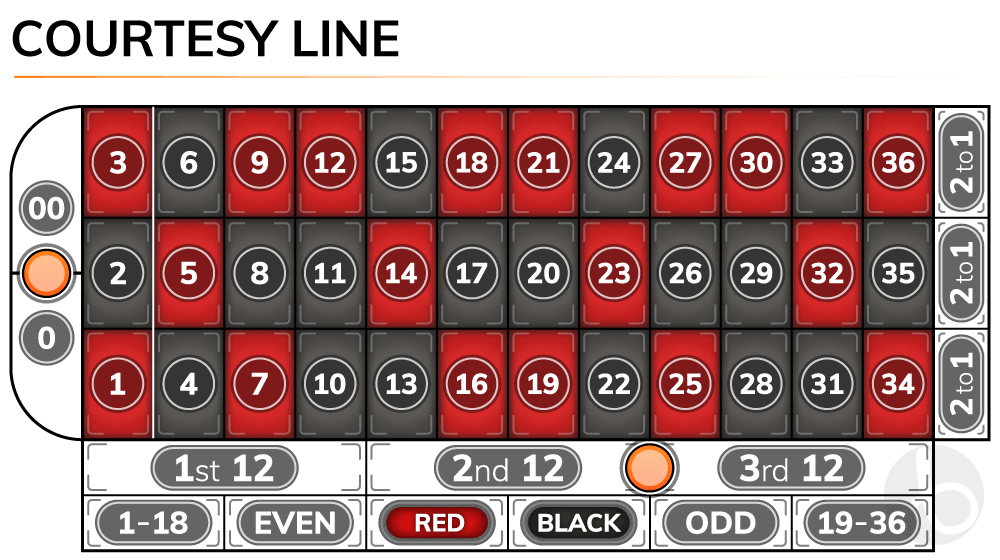
When the table is packed and you can't place the chips yourself, come casinos let you place call bets. You tell the dealer how much you're betting and on what, and they'll mark the bet on the table.
Since you don't put the chips on the table when placing a call bet, technically you're gambling on credit. That's why brick-and-mortar casinos in the UK won't accept call bets. Even outside the US, casinos are not always willing to allow anyone to play on credit and make call bets.
Instead, casinos often accept announced bets. The difference is that the player needs to have the necessary chips on the table to cover the bet.
Announced bets or French bets are courtesy bets which the dealer will handle if he has the time to do so. The bet is only accepted if the dealer repeats it out loud.
Once the dealer calls out "No more bets" and waves a hand over the table, no more bets will be accepted. If you place a bet after this call, it's null and void. It will be returned to you along with a cold stare from the dealer and some angry looks from your fellow players.
The number on which the ball stops is the winner. The dealer calls out the number and places a marker on that number on the felt. The marker is called dolly and looks a bit like a chess piece. It's usually a couple of inches tall and made out of either clear plastic or brass.
When the dealer removes the dolly, take your chips. If you leave them on the table, you're betting them again on the same number.
Common courtesy and politeness will go a long way at roulette tables. If you need help or instructions, the staff is there for you.
Below, we give you some tips on how to behave at the table.
At busy times, roulette tables can get quite packed. Once you've placed your bets, it's polite to take a small step back to let others in.
Watch your stance. Try to stand sideways and don't hog too much space.
Roulette has a history as an upper-class game, and the behavioral norms at the table date back to the 1800s. Back then, the idea was to take both wins and losses in a stride, and not make a show of emotions one way or another. In fact, contemporary accounts speak of deadly silence at the tables.
The modern roulette culture isn't quite so uptight. However, certain calmness and moderation are expected. You can celebrate your win. You can be disappointed if your bet didn't come through. However, don't rub your joy in anyone's face or take your losses out on your fellow players or the staff.
Food is usually not allowed at roulette tables.
The rules regarding drinks vary. The table may have a separate railing with slots for drinks. If so, it's OK to drink at the table.
Never place your drink on the felt. Spilling your drink on the table will cost you dear. The casino will have to clean the felt and close the table for that time. The spiller foots the bill.
You may get free drinks at the casino. It's OK to enjoy them, but don't get too drunk.
Some casinos are split into smoking and non-smoking sections. Obviously, it's not OK to smoke at a non-smoking table.
Even at a smoking table, it's impolite to blow the smoke towards the dealer or the other players. Instead, blow your smoke towards the ceiling.
Keep your ashes neat. If the table has a railing for the drinks, it'll probably accommodate ashtrays too. Don't let the ashes fall on the felt or the floor.
Don't use any electronic equipment at the table. This includes phones, cameras etc.
Never touch other players' chips, unless you're asked to place a bet for them.
If the dealer makes a mistake, point it out politely. Your feedback will be better received.
Tipping practices vary around the world. In addition to culture, local regulation may dictate whether or not tips are allowed.
In the UK, dealers can't accept personal tips. Instead, tips are pooled together with other staff from that shift.
In the US, tipping is the norm. When and how much to tip is a matter of taste, but here are some guidelines for tipping your dealer:
As you play:
As you leave:
Alternatively or in addition, you can place a bet for the dealer. However, most dealers appreciate a fixed sum instead of an unsure bet.
Tip the drinks runner. $1 for every drink brought to the table is the norm. You're probably not paying for the drink itself, but it's polite to have the tip handy.
Tip with cash, not with chips. The chips are the casino's property and technically not yours to give away. Besides, you're playing roulette. Roulette chips are different from casino chips and only good at that specific table for the duration of your session.
In addition to roulette tables operated by real human dealers, many brick-and-mortar casinos offer automatic roulette games. There are two main types:
To the player, the two versions are very much alike. However, there are technical differences that affect the feel of the game and the cost to the operator.
Electronic or digital auto roulette is just an RNG roulette with a touch screen. The random number generator of the gaming software determines the results and there's no physical roulette wheel or ball.
From a technical standpoint, the physical roulette machines are a bit more complicated. These airball roulette machines are fitted with plenty of gadgets to keep the game running and to pay out the winnings correctly.
Here's how you play a physical roulette machine:
At most casinos, a single airball roulette machine has up to six betting terminals. This means up to six players can bet simultaneously on the same game. However, there's no dealer running the show and instead of chips, the game uses digital money via your player card.
All this leads to a much faster pace and efficiency, although the atmosphere isn't exactly the same as at "real" roulette tables.
For four centuries and counting, players have tried to beat the odds and find the perfect betting system for roulette. As a result, you’ll now find many roulette systems circulating online. This step-by-step guide walks you through well-known strategies, plus a system of our own devising.
This is the list of the most popular and well-known roulette strategies. We've also included a paid strategy we bought online, and one we devised ourselves.
Roulette strategies are betting systems designed to beat the game and overcome the house edge. In most of the strategies listed below:
In the short term, they may. In the long term, though, they tend to fail.
There are no flawless gambling systems based purely on roulette statistics and betting progressions.
If such a thing as a secret betting system for making money from roulette at online casinos existed, everybody would have pounced on it already.
The internet is full of conmen trying to sell you the perfect system, and we even checked out a few. As expected, they're just variations of the same old strategies that have been around for decades. Don't waste your time or money on them.
To be sure, there are successful roulette players who make sizable profits from the game. However, they generally attribute their wins to observing and exploiting the wheel bias and other physical giveaways of roulette. More on this in the chapter on Roulette physics.
The major pitfall of all roulette systems is the gambler's fallacy. It's a belief that if an outcome of a game has occurred before, the opposite is bound to happen soon to balance things out.
There's no scientific basis for this. However, this fallacy leads players to make the wrong assumptions and decisions.
Let's take a classic example from over a century ago. On the 18th of August in 1913, the Monte Carlo Casino witnessed one of the most epic streaks in gambling history. The ball landed on black 26 times in a row.
The odds for hitting 26 black numbers in a row are 1 to 67,108,863. Does that mean the odds for the 27th number being red are better than the standard 18 to 19? Absolutely not.
Unlike blackjack where you can count cards to determine the likelihood of getting winning hands, every spin of the roulette wheel is a random event. It's unrelated to the outcomes of previous rounds. The roulette ball has no memory, conscience or shame. The previous spins or statistics don't make a dent in the odds of an individual spin and neither do they lower the house edge.
The unlucky bettors in Monte Carlo thought that a red number was bound to come up soon, and eventually, it did. However, many started betting and raising their stakes on red early on. In this losing streak they painfully found out just how random the roulette wheel can be.
Fittingly enough, the gambler's fallacy is also known as the Monte Carlo fallacy.
One of the key differences between the systems is whether they're a negative or positive progression:
Some of the strategies let you recoup all your losses with one glorious stroke of good fortune; others take a bit longer. The instant win strategies are naturally riskier.
Most of the systems are applied to even money bets, where the payout is 1:1. In a roulette table, these bet pairs are red/black, odd/even, and 1-18/19-36. We use red and black in the examples for simplicity, but you can choose any even money bet instead.
The majority of the roulette betting systems are negative progressions, meaning you raise your bet after a loss. The core idea is that by betting more on the next spin, you need a smaller number of winning rounds to square your losses.
Roulette, however, is an unpredictable game with potentially long losing and winning streaks. Even if you have the budget to keep raising your bets, there are also table limits to take into account.
The statistics of roulette reflect the odds in the long run, but the same doesn't apply to a single session, let alone one spin.
Proponents of roulette strategies see things differently: raising the bet gives you enough time for the stats to work their magic, provided that an extremely unlucky losing streak doesn't clean out your bankroll.
If you're playing the standard European roulette, the house edge is 2.3%. That won't budge by changing the bet size. You might get lucky many times, even within a single session. You also need to be prepared to encounter some really bad runs.
If roulette systems don't improve your chances of winning, what's the point?
In our view, using a system brings structure to an otherwise completely random game, even though it doesn't guarantee success.
Ian Fleming put it well in the very first James Bond novel, Casino Royale in 1953:
This is the essence of all roulette strategies. You can immerse yourself in a complicated system and slowly grind towards your goal. Alternatively, you can take big risks and expect instant big rewards or corresponding big losses.
Whatever your taste, enjoy the game, know your odds and don't risk money you can't afford to lose.
In this guide, we often talk about chips or betting units. This is the smallest amount of money you use to adjust your bet. For most progressions, a single chip is your starting bet. It's also the smallest increase or decrease you should make to your bets when following a system like d'Alembert.
Choosing your chip denomination is up to you. Most of us will do well by sticking to the table minimum. That leaves a lot of room to take the progressions further without exceeding the gaming budget or table limits.
High rollers should keep this in mind too: if you want to try out the roulette systems with some serious cash, choose a table with a low minimum and a high maximum bet. This gives you a lot of range to raise your bets according to the betting progression.
Remember that in addition to table limits, casinos impose a maximum bet when you're playing with a roulette bonus. In order not to have your winnings impounded, don't go over the maximum bet specified in bonus T&Cs.
Martingale is a negative progression roulette strategy. You double your bet after a loss and start from the beginning after a win.
The appeal is understandable: the winning number will come eventually. When it does, you'll get ahead with just one lucky spin.
Martingale is very easy to use but asks for deep pockets, nerves of steel and the ability to stick to your limits. Here's how it goes:
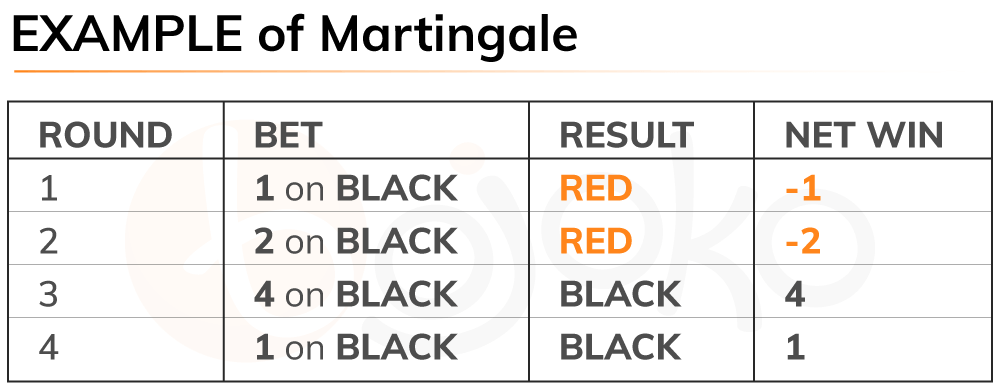
There are two obvious shortcomings in the martingale strategy:
EXAMPLE: If you have to double 10 times, your bet will be 1,024 times your original wager. Even if you win on the next spin, you'll only net one chip.
Cut your losses. There's nothing you can do about the limited gains of the martingale. However, you must know when you've reached your limit and not raise your bet above that. You'll be kicking yourself if the next spin is a winner, but 19 out of 37 times you'll be patting yourself on the back.
Play more predictable games. You can apply the martingale strategy to games where the previous rounds have at least some bearing on the future. Baccarat, blackjack and other card games dealt out of a shoe are perfect examples, although the next hand to be dealt still isn't set in stone.
Wait for a streak. Nobody wants to run into a long losing streak. You can wait for several similar results in a row and only then start betting on the opposite outcome. It won't affect the odds of an individual round, but statistically, you do see less losing streaks of 10 rounds than 5. This isn't a foolproof system and you'll still need to stick to your limits.
If an unlikely streak of losing numbers can make you lose an exponential amount of money, a winning streak can earn you an exponential pile of chips, right?
This is the idea behind the reverse martingale system, also known as paroli. As the name suggests, this is the opposite of martingale:
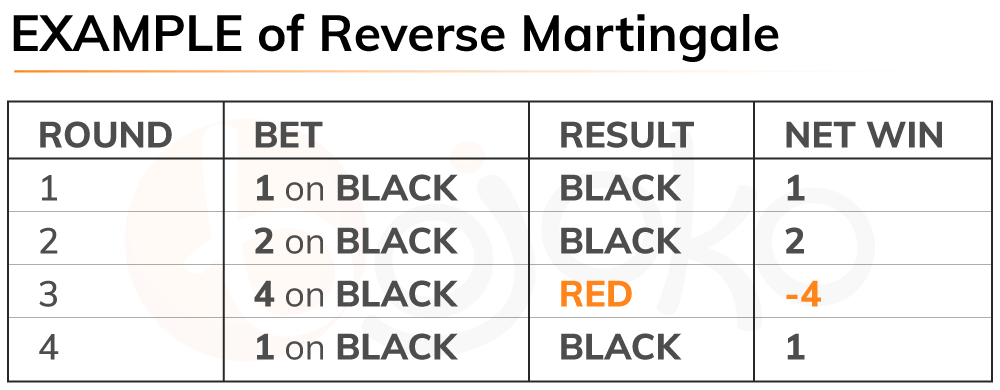
The key to a successful reverse martingale lies in knowing when to take your wins instead of trying to double them further. No matter how many chips you win during your run, betting and losing them all on the next spin will leave you in the red.
However, if you quit while you're ahead, you can start hunting for that next winning streak with a bankroll big enough to endure a few losses on the way.
So how does reverse martingale compare to the original version? Whereas the standard martingale will bring you slow but steady gains (until you hit a bad streak that busts your bankroll), the reverse version works the other way around. You'll steadily lose 1 unit every time you miss, and only win when you have a sufficiently long winning streak.
How long a winning streak do you need? This is down to personal preference. The odds for winning remain the same for each turn. Ideally, you'd win enough to cover the previous losses and then some. But if you keep waiting for this perfect run, you might miss out on some opportunities to take your wins before you end up losing.
The d'Alembert system is a very simple roulette strategy named after the 18th-century French mathematician, Jean-Baptiste le Rond d'Alembert.
Just like the martingale, the d'Alembert system is also a negative progression. However, it doesn't let you recoup all your losses in a single spin. Here's how it works:

How much can you win with the d'Alembert strategy? If you win exactly half of the bets you place, d'Alembert nets you the total number of winning rounds played times your chip size.
With d'Alembert, you can get ahead when you're losing more rounds than you're winning, although the odds don't allow for much of a difference. On the other hand, a long session with plenty of losing rounds can raise the bet to an uncomfortable level. However, this won't happen as quickly as with martingale.
Unlike martingale, d'Alembert doesn't let you recoup all your losses at once. If you've had a bad run, climbing out of the hole will take some lucky bets that might have to be many times higher than what you started with.
Still, d'Alembert is one of the safer roulette strategies. You might not win big, but a nasty streak with tragic losses is also quite unlikely.
Surprise, surprise, d'Alembert comes with a reverse twin too. There's a very significant weakness to this system, however. You need more winning than losing rounds to break even. You have to achieve this with flat bets too.
Granted, it's more difficult to apply than most strategies. If you're having a good day with roulette, the reverse d'Alembert can boost your winnings even further. Give it a go if you're up to it:
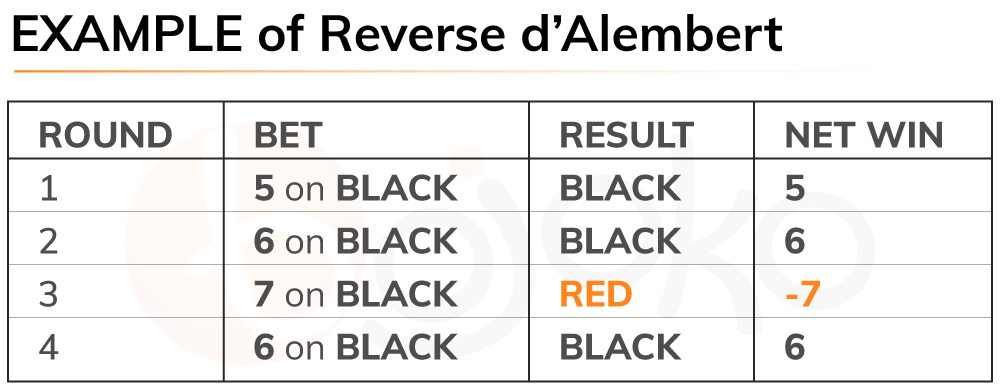
Just like other positive progressions where you increase your bet after a win, you need to quit while you're ahead. You need to have an instinct for when to grab your money and step away from the system. Better yet, set yourself a limit, e.g. take your winnings after 5 consecutive wins.
The Fibonacci strategy is not just one roulette system but a collection of different betting strategies. The unifying theme is the attempt to get an edge over the house by upping the bets according to the Fibonacci sequence.
The first 10 numbers of the Fibonacci sequence are 1, 1, 2, 3, 5, 8, 13, 21, 34 and 55.
The classic Fibonacci system is played on even money bets. Here's how you can apply it:
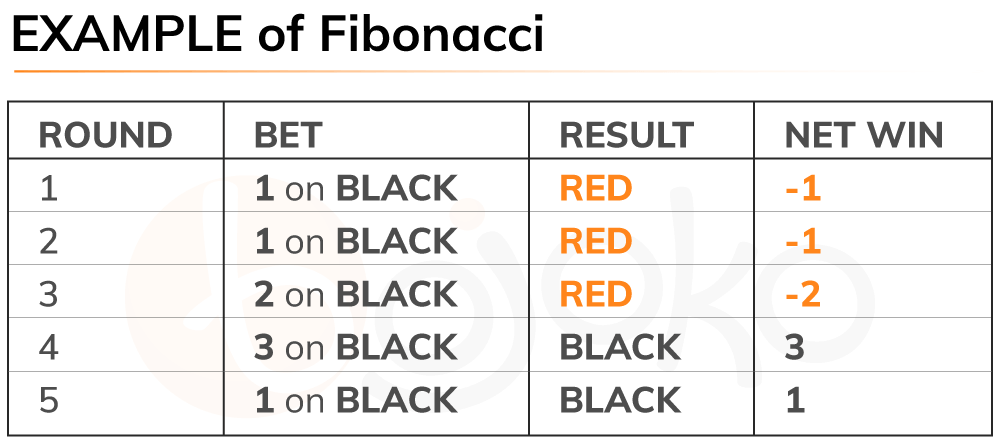
The Fibonacci betting system promises neat gains even when you win only 33.34% of your bets.
The only stumbling block is the usual long losing streaks. Even if the statistics balance themselves out eventually, this may not happen within your playing session. Your bet amount might spiral above your budget or table limits during a bad run.
You can limit – but not entirely eliminate – these occurrences by:
Just remember that the odds for an individual round don't ever change and supersizing your bet might be just another way to dig your hole even deeper.
The Fibonacci dozens strategy was developed by the Bojoko team a few years ago. Although we've found systems with similar elements afterwards, our version is quite elegant.
Fibonacci dozens offers another way to apply the Fibonacci sequence in roulette. Unlike most other systems, this one uses the dozen and column bets with a higher 2:1 payout. The losing streaks may be longer, but your net win increases with the added risk.
Here's how to apply it in practice:
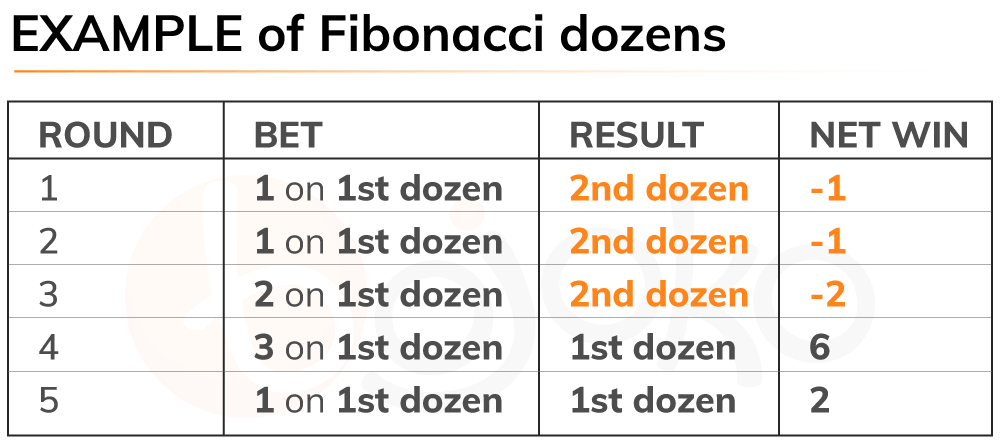
Since this strategy is somewhat risky, there are steps you can take to make it less so:
With Fibonacci dozens, you play the bets with 2:1 payouts, i.e. dozens and columns. The bet size grows as quickly as in the classic Fibonacci system. However, you need only one hit to get ahead and start from the beginning.
Compared to martingale, the net wins are also bigger and grow alongside the overall bet size. The bigger the risk, the bigger the reward.
Winning early in the sequence will net you higher gains as a percentage of your total bets. But the monetary net win will increase the further down the sequence you go.
EXAMPLE: Starting with a £1 bet and winning on the first spin will net you £2, whereas winning on the 10th spin with an £89 bet will net you £36.
However, with 2:1 payouts the losing streaks are more frequent than with 1:1 bets. We've often witnessed the ball miss a certain column or a dozen over 30 times in a row. We've busted the entire bankroll while trying to take advantage of such freak streaks. That's why it's important to stick to your limits.
The Labouchère system is also known as the cancellation system. It requires some scorekeeping but leaves room for adjustment. You can choose the numbers on the list yourself. Your profit for a completed betting sequence is the sum of your original numbers.
Here's how it works:
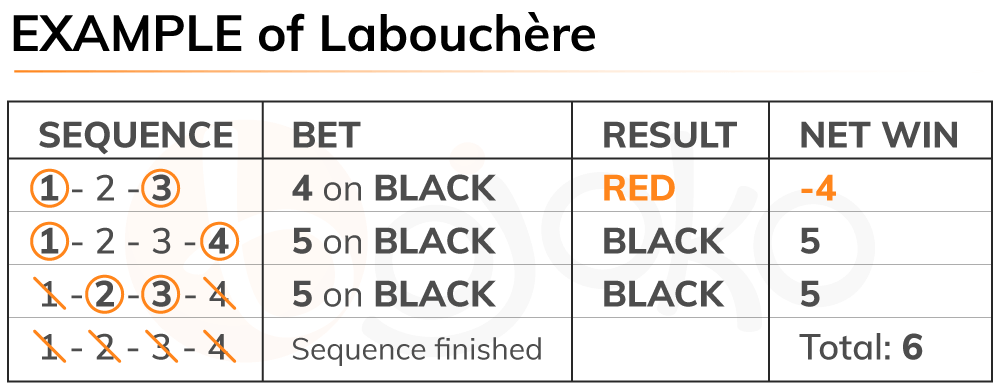
Labouchère strategy was originally invented by an 18th century French mathematician Marquis de Condorcet. However, the system takes its name from Henry Du Pré Labouchère. He was an English politician from the Victorian and Edwardian eras and put this system to practice across all of his gambling pursuits.
To apply the Labouchère strategy, start out by writing down a list of numbers. At the end of a successful betting sequence, the sum of these numbers is your net gain. The list can be as simple as 1-2-3-4-5, but you can select any numbers you like.
This makes the Labouchère system a truly customisable strategy. You can adjust the risk and reward according to your preference by going for a more or less aggressive progression.
The strength of the Labouchère system is that you only need to win 33.34% of the rounds to make it work for you. Playing even money bets should, on average, see you winning 47.37% of them, so what could go wrong?
The problem is that roulette is an unpredictable game with long streaks of wins and losses. The average win ratios occur over a long time, not necessarily during a single session. With an unlucky streak, your bet will grow speedily and exceed either your budget or table limits. Then you'll have to stop before completing the list.
You can have some great sessions playing with the Labouchère system. In the long run, the big losses of really bad runs will probably eat away the smaller gains of the successful betting sequences.
Oscar's grind is a roulette system that first appeared in Allan Wilson's 1956 book Casino Gambler's Guide. In the story, Wilson interviewed a disciplined and patient gambler called Oscar. He revealed the secret of his slow but steady winning system.
In Oscar's grind, the gameplay is divided into betting sequences. In each sequence, your target net win is equal to your original bet, e.g. 1 chip.
Here's how it works:

Oscar's grind is one of the safest roulette systems you can try, and also one of the slowest. It withstands bad losing streaks with panache. However, with quickly alternating win-loss sequences, the bet amount can quickly reach undesirable highs. To get out of this, you need a decent winning streak.
James Bond, agent 007 of Her Majesty's Secret Service, is no doubt the most famous fictional gambler of all time. The man himself has even spawned a betting system that does the rounds online.
To be sure, there's no official source for this strategy in any of the Bond movies or the original novels by Ian Fleming. If you can tell us where it originates, we'd be happy to know.
Let's delve into the James Bond roulette strategy step by step.
The oft-quoted version of the James Bond system uses a total starting bet of £200. Everyone can adjust this to suit their budget. Instead of the total of £200, you can go as low as £20 at most live dealer roulette tables with a £1 minimum.
In our example below, we use the neutral term 1 chip, and you can decide the denomination yourself.
Place the following bets:
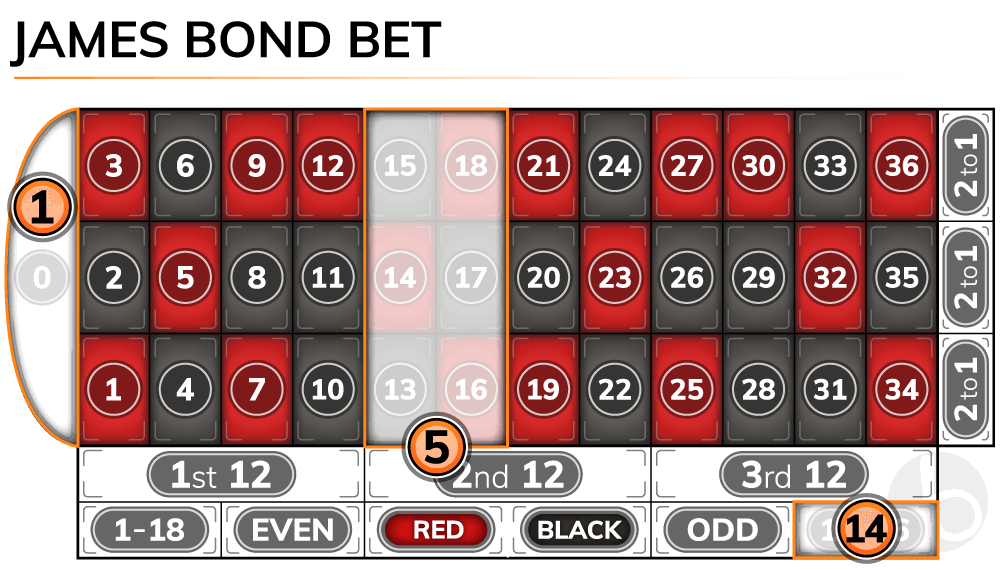
The net win varies, depending on where the ball lands:
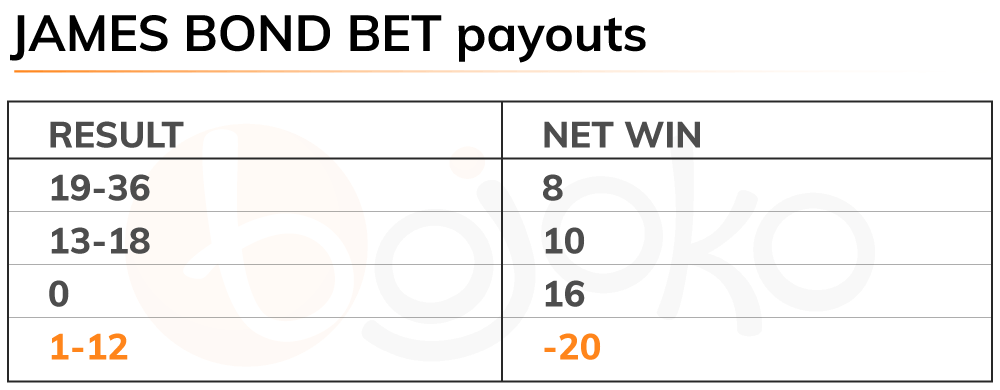
James Bond isn't exactly a betting system, but a combination of bets that covers over two-thirds of the roulette table. If you lose, you can either continue with the same bet size, or increase it according to any other betting strategy listed above.
In the 1990s, Jacob Kanzen came up with a roulette system called Gambler's Luck. He's been selling his system as an ebook for almost a quarter-century. We decided to check what it's all about.
Kanzen's system is based on the notion that a casino's house edge only materialises when you win. The payouts are set to include the house edge, so every time you win, the casino takes its share. We explain this thoroughly in the section Roulette odds.
That's why Gambler's Luck aims for big, less frequent wins. To achieve this, the system relies on betting on a single number over and over again. After a successful spin, you expand your bet to cover the neighbouring numbers on the wheel and double the bet size. After a losing spin, you go back to betting on the single number with the normal bet size.
We tested the system thoroughly with two RNG roulettes to get a sample of thousands of spins. We were betting on 0 and expanded the bet to cover 26 and 32 after each successful spin. We did have some initial success and at some point were up by 250 chips. However, we only managed to hit two wins in a row twice during the long session, and ended up losing more than we won.
Kanzen talks a lot about money management. The system includes specific rules on when to call it quits. To be fair, if we had closely followed Kanzen's money management rules we would have limited our losses considerably. However, we wanted to see what happens if this system is pushed to the limit.
Kanzen's ebook comes with some theoretical justifications for the system. However, we think his notions concerning the house edge are somewhat flawed and beside the point.
If you want to read more about Kanzen's theories and his betting strategy, you can download the ebook from Kanzen's website.
Physical roulette wheels don't produce 100% random results. Players have invested time and money to track these imperfections and devised tools and strategies to use them to their advantage. In this section, we look closely at the roulette wheel and how its flaws can be predicted.
Blaise Pascal invented the roulette wheel in the 17th century. However, the wheel gained popularity at the turn of the 19th century, around the time of the French revolution.
The structure and manufacturing of roulette wheels has evolved during the past 300 years. Yet, the basics have remained the same. To a large extent, roulette wheels are made by hand.
Here are some of the key specs of a modern roulette wheel:
Below, you can watch a video from a casino equipment manufacturer SET-Production to see how roulette wheels are made.
Although a lot of work goes into making and maintaining a roulette wheel, the wheel is never perfect. Even brand new wheels may have a tiny bias. Over time, the wear and tear will cause some parts of the wheel to deteriorate and start producing results that differ from the expected average.
These are the usual suspects behind wheel bias:
All of the factors listed are tiny imperfections and mostly undetectable to the naked eye. However, experienced players can observe the results and make their conclusions.
To do this only by sitting at the table and keeping a mental tally of the spins takes time. That's why some use roulette computers to track and analyse the wheel results.
There are techniques you can use to analyse the trajectory of the roulette ball during the spin. To use them, the casino needs to allow late betting.
Late betting means that the dealer accepts bets for a while after the wheel is spun and the ball in the groove. Between the spin and the dealer announcing "No more bets", you'll need to be able to figure out where the ball will land and make your bets.
There are people that can do this all in their head. For those with a mind to absorb such information, here's an academic, peer-reviewed article on Predicting the outcome of roulette, written by Michael Small and Chi Kong Tse.
Analysing the roulette spin with the naked eye and predicting the outcome can be done with enough accuracy to turn the odds in favour of the player. However, with the right equipment, advantage players can increase their edge over the casino even further.
Roulette computers are wearable devices with a camera to track the ball on the wheel. To predict where the ball will land, the computer needs a couple of seconds of a steady image of the ball rotating the wheel. After this, the computer suggests where to bet.
Technically, using roulette computers is legal in many jurisdictions. However, casinos will throw out anyone using them and ban them for life.
Probably the most famous case of using roulette computers comes from London in 2004. A team of Eastern European advantage players won over £1,000,000 at the Ritz over three days, using a roulette computer.
The team aroused the suspicion of the Ritz security and was arrested by the police. However, they hadn't broken any laws so they kept their winnings and walked away scot-free.
To prevent players from gaining an unfair advantage in roulette, casinos can call "No more bets" earlier than usual.
If the advantage players don't have the time to analyse the spin with a computer or a visual technique, they can't place advantage bets.
Most casinos allow late betting, i.e. placing bets even after the ball is in motion. It speeds up the game and builds up excitement, which both result in more chips on the table.
That's why calling "No more bets" early is only used when the staff spots an unusually lucky player who bets late. Disallowing late betting will either cause them to lose or drive them off the table.
Obviously, advantage players don't want to be flagged as such. That's why they sometimes lose on purpose to disguise their winning patterns.
There are different types of roulette tournaments available both at brick-and-mortar casinos and online. In this section, we explain how they work and how you can optimise your play to climb the leaderboards.
In roulette tournaments, you compete against other players. Your job is to grow your chip stack higher than the others within a pre-specified time limit. Whoever has the most chips, makes their way to the next round and ultimately wins the tournament.
Roulette tournaments have an entry fee called the buy-in. With this fee, you get a set number of chips to play the tournament. Usually, you can't buy more chips during the tournament.
Depending on the tournament, the buy-in can range from £5 to several hundreds.
Players attending the tournament are divided into groups. At brick-and-mortar tournaments, the players of the same group play at the same table.
During each round, a set number of spins are played. Depending on the rules, you may need to bet at least a set number of chips each round.
After all rounds are played, one or two players continue to the next round and the rest are eliminated from the tournament.
In the final round, the winners of the previous rounds go head-to-head. The winner is the one with the most chips after the round is over.
The main prize of the tournament is based on the buy-in size and the number of attending players. In addition to the first prize, the second and third players may also get something.
You can usually find online roulette tournaments at:
At such casinos, roulette tournaments may be a regular feature, taking place once a month or even once a week. Unlike brick-and-mortar tournaments, online roulette tournaments may last days or even a week.
The rules at online tournaments vary. For example, you may be allowed to spin the wheel with your regular casino balance instead of a separate buy-in. Naturally, such a rule favours high rollers who can afford to risk more to win more.
Before you enter, make sure you have the following information:
How you play at the tournament depends on several factors:
Concentrate on slowly building your bankroll with outside bets. Don't take unnecessary risks. You're not desperate - yet.
Continue building your stack and staying ahead of others with conservative bets. Others have to take the risks to catch you. As long as you are comfortably leading, carry on.
If you find yourself losing more than you're winning and the chip leader running away from you, it's time to take bigger risks.
Especially if you're playing with the buy-in, consider raising your bets and focusing more on inside bets. They have higher payouts and you need them in order to catch up. Yes, you may fall out of the tournament early. However, you'll be eliminated anyway, if you're not among the top players of your group.
If you're playing with your own money instead of a pre-set buy-in, the call is up to you. Do you want to take bigger risks to win a tournament you're unlikely to win, or do you take what's left of your stack and walk away?
Roulette tournaments are just one type of casino competition. Like any others, they've been designed to draw a crowd.
The winning structure of the tournament is usually designed to cover the costs and even turn a profit. In addition, once the tournament is over, players may stick around to try their luck at other games as well.
Roulette is an old game. The version we know dates back to the French revolution, but its predecessors are hundreds of years older. In this section, take a look at the history of roulette. How did it evolve from a regular cheat's game in Venice to a global phenomenon?
This chapter is largely based on David G. Schwartz's brilliant book, Roll the Bones: The History of Gambling. If you're interested in the background of this pastime, we recommend this analytical and entertaining work.
The first descriptions of roulette date back to Paris in 1796. However, roulette has recognisable elements of other, older games.
Roulette is a combination of a game called biribisso and English wheel-based games, including roly poly, EO and ace of hearts. These games evolved from a perpetual motion machine prototype, invented by a French mathematician Blaise Pascal.
Biribisso (biribi or cavagnole in French) dates back at least to the 17th century. It was played at Il Ridotto, the first state-sanctioned casino of the world, located in Venice.
Instead of a wheel to determine the winning number, biribisso features a bag containing numbered balls. Players take turns drawing the winning number from the bag, held by the croupier.
Just like roulette, biribisso features a betting area with rows of numbers. Versions with different amounts of numbers exist. The indoors version featured numbers from 1 to 70, whereas the "street" version had only numbers from 1 to 36.
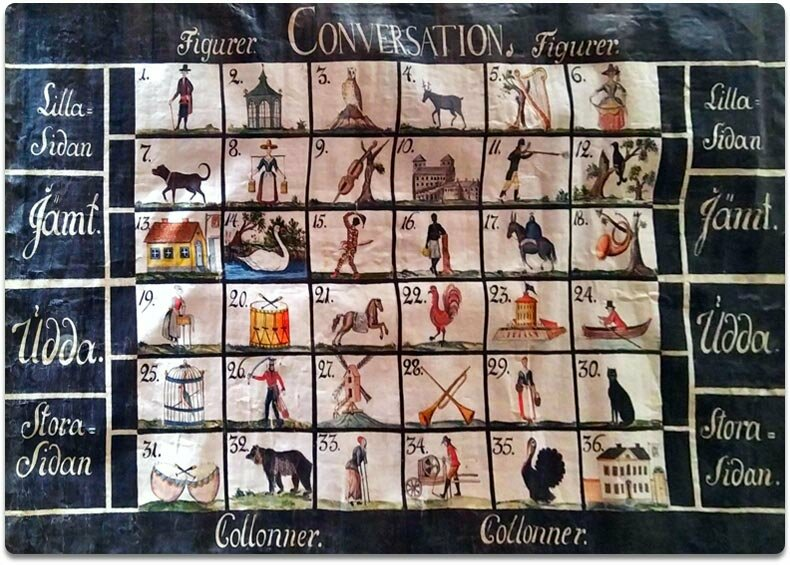
In the image above, you can see a biribisso board from the 1790s. It was found under the floorboards of Louhisaari manor, Finland. The game board features a 6-by-6 grid of numbers with elaborate illustrations, including the nearby Turku castle on tile 10, and probably the manor itself on tile 36. There are also betting areas in Swedish for lilla sidan (small side), stora sidan (big side), jämt (even) and udda (odd).
According to contemporary tales, biribisso was considered a cheat's game. Working in collusion with the bag holder was common. During the 18th and 19th centuries, biribisso and similar games were banned in many European countries.
The roulette wheel was invented by the French mathematician Blaise Pascal in the 17th century. Pascal was trying to build a perpetual motion machine, but failed. Although the wheel will spin for a long time on its own, it will eventually come to a halt.
However, Pascal accidentally created a machine that produced relatively unpredictable results. Compared to drawing numbered balls out of a bag, Pascal's wheel was a huge improvement.
Roly poly, ace of hearts and EO (even and odd) are the English predecessors of roulette. They featured a horizontal wheel with different tiles to bet on.
The earliest sources referring to roly poly are from 1713. However, the game itself isn't described. Later, the term roly poly is used synonymously with EO.
We do know something about the other two, though. Instead of numbered tiles, ace of hearts had playing cards painted on the wheel. The British Parliament outlawed the game in 1739, but it soon reappeared in a revamped version.
Even and odd (or EO, as it was commonly known) replaced the playing card symbols with three types of slots: 17 for even, 17 for odd and 2 for instant bank win.
By the end of the 18th century, the English roulette predecessors had made their way to France. In 1796, The Palais Royal gambling house of Paris featured a game we would recognise as American roulette.
The Palais Royal version featured two slots for zero and all the roulette bet options available in the modern version. These included straight bets, splits, corner bets, dozens, columns and even money bets.
The game gained popularity, but its legal status went back and forth throughout the continent. Local rulers who saw the opportunity enjoy their share of the gambling profits, ensured it remained legal only when they got in on the action.
Spa towns were the main tourist attractions of the late 18th and early 19th centuries. Wealthy people with time and money to spare between soaking in baths were happy to spend both playing roulette.
In the early 1800s, roulette was the money maker of several spa casinos, including those of Spa, Ems, Wiesbaden, Baden-Baden and Bad Homburg.
The early versions of roulette had two slots for zero: 0 and 00. When French gambling entrepreneurs Louis and Francois Blanc were opening up their casino in Bad Homburg in 1843, they needed a way to stand out from the competition. Their solution: remove the second zero.
Blancs' single zero roulette was a hit. It helped put their new casino Kursaal on the map.
Soon, the single zero roulette became the norm around Europe. However, the double zero roulette was imported to America. Casinos in the United States and the Caribbean still use the two zero version, whereas other parts of the world go for the single zero variant.
In the latter half of the 19th century, Monaco became the gambling hub of Europe. Here too, Francois Blanc was the mastermind behind the rise of the new Monte Carlo casino. In the 1860s, Blanc was promoting a marketing approach "Homburg in the summer, Monaco in the winter". Players from around Europe were flocking to Monaco by the 1870s.
Monte Carlo casino was slow to adopt the use of chips at its gambling tables. In the early days, roulette players would bet paper money and coins. Croupiers had to keep track of which stakes belonged to whom.
The half-century preceding the first world war was the golden era of both Monte Carlo and roulette systems. Players tried to gain an edge over the game by trying all manners of betting progressions. Some even managed to convince others they had a winning system and got them to back their attempts to beat the casino at their own game.
The casinos encouraged the use of betting systems and made a spectacle every time a player "broke the bank". When the table ran out of chips, the staff would ceremoniously cover the table in a black cloth until new chips were brought to the table.
While some players relied on betting systems to break the bank, others tried to find patterns in the results of the roulette wheel.
In 1873, an English engineer Joseph Jaggers hired assistants to note down the results of each roulette table at Monte Carlo for a week. On one of the wheels, the ball repeatedly stopped on the same 9 numbers: 7, 8, 9, 17, 22, 28 and 29.
Having spotted a pattern, Jaggers took advantage of the situation. To throw the casino off his scent, he masked the numbers he was playing by placing random bets as well. Over four days, he managed to win £60,000.
The casino staff understood that something was up. They first switched the wheels, but Jaggers spotted his wheel and continued to win. After this, the casino ordered some replacement parts from Paris and recalibrated the wheel. Jaggers didn't push his luck any further and left Monte Carlo £80,000 richer.
Although Jaggers's success caused the casino to lose some money in the short term, it taught the industry a valuable lesson. Monte Carlo started to test and level each of the casino's roulette tables every day before opening the doors to the public.
A few players did win with roulette systems. The most famous of them was Charles Deville Wells, a.k.a. "The man who broke the bank at Monte Carlo". Wells was a con-artist and a swindler. Having raised money with some dodgy inventions, he bought a yacht and sailed to Monte Carlo.
According to a gambling historian David G. Schwartz, Wells used a modified version of the martingale betting system to break the bank several times. Over the course of his Monte Carlo visit in the summer of 1891, Wells turned his starting capital of £400 into £40,000. He returned to Monte Carlo in November to win £10,000 more.
Wells soon inspired a British music hall song The Man Who Broke the Bank in Monte Carlo, written by Fred Gilbert in 1891. In the video below, you'll see it performed by Charles Coborn in the 1930s.
Eventually, Wells' luck ran out. During his January 1892 visit, he lost a large part of his previous wins. When he tried to talk more investors to back up his infallible roulette system, his old business partners turned to the police. Wells was shipped to England, convicted of fraud and sentenced to 8 years in prison, where he eventually died.
Ever since its founding in 1718, New Orleans was a gambling hub. After the Louisiana purchase in 1803, the city became the gambling capital of the United States.
At first, roulette wasn't a big hit in the west and couldn't compete with America's game of choice faro. However, the city of New Orleans experimented with legal gambling starting in the 1820s and roulette found its way into American gambling halls.
The official attitudes towards gambling varied around the US, but there were always players wanting to try their luck. Even in the frontier, gambling tents were some of the first to come up.
Roulette, however, wasn't as portable as many other games. That's why it could usually be found only at permanent gambling halls and riverboat casinos. Even there, it was a game among others.
In the early 20th century, the United States had casinos that could rival their European counterparts in exclusivity, refinement and high stakes. In Saratoga Springs, New York, the roulette tables had an upper limit of $50,000 on even money bets, twice as high as Monte Carlo.
One reason casinos were slow to add roulette to their offering was the relatively low house edge. To combat this, the American roulette saw some updates in the early 19th century. These tweaks turned the odds in the favour of the house.
Instead of the European layout with numbers from 0 to 36, the American wheel soon came to bear numbers ranging from 0 to 28. In addition, it had a double zero and an eagle symbol, both resulting in a house win. This raised the house edge from 2.70% to a more favourable 9.68%.
This steep house edge was too much for some gamblers. During the next decades, the eagle symbol was dropped and the numbers 29 to 36 returned on the wheel. However, the second zero remained and today we know this version as American roulette.
Nevada had been going back and forth over the legal status of gambling even before it became a state in 1864. At the start of the 20th century, there were small scale gambling operations in Reno and Las Vegas.
The real boom started with the building of the Hoover dam and legalisation of gambling in 1931. For almost 50 years, Nevada had the only legal casinos in the US. The new dam and the nearby air force brought more people to Vegas, and the city grew fast during the next decades.
Starting in the 1940s, new casinos started to open outside the city limits, on a stretch of highway from Los Angeles to Salt Lake City. This new area called The Strip became the focal point of future casino development, overshadowing the actual city of Las Vegas.
Roulette played in Las Vegas and on the Strip hasn't evolved much since the early days. American roulette with two zeros was and still is the standard version. However, many casinos have added a single-zero wheel and even la partage rule to attract high rollers.
In the past few years, the triple zero roulette has appeared on the Strip. Although not quite as bad as the eagle roulette of the 1800s, it still has a very steep house edge of 7.69%.
In 1976, the state of New Jersey legalised casinos, as long as they were located in Atlantic City. The first legal casinos opened two years later, and the city saw a gambling boom during the 1980s.
Atlantic City roulette differs slightly from the version played in Las Vegas. Roulette tables at Atlantic City use the double zero wheel of American roulette, but they have the la partage rule of French roulette.
When the ball stops on zero or double zero, even money bets return half of the original stake. As a result, the house edge is only 2.63%, on par with European roulette that Las Vegas only offers to high rollers.
The online gambling boom started in the mid-1990s, and really took off after the turn of the millennium and the online poker craze.
Frankly, the early online casino games were ugly by modern standards, but as a simple game, roulette didn't need flashy graphics. As one of the staples of the brick-and-mortar casinos, it also became popular online.
Over the years, roulette game developers have come up with innovative new versions of roulette. In addition, they have re-created the traditional games to capture the authentic atmosphere.
The biggest innovation was replacing the random number generator with a live human croupier and broadcasting the stream to hundreds of online casinos. Since then, live dealer roulette has broken to the gambling mainstream and can be found on practically every online casino.
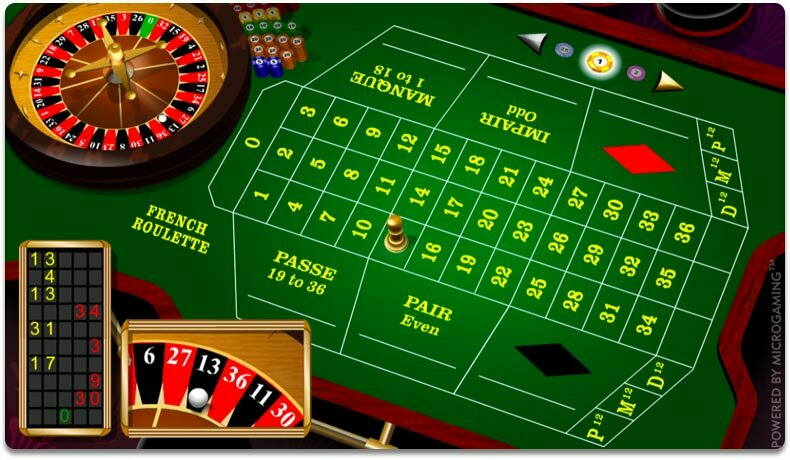
French Roulette by Microgaming, launched in 2004.
In this section, we answer the most common roulette questions, including who invented roulette, what are roulette balls made of and what are the best roulette variants.
A French mathematician called Blaise Pascal (1623 - 1662) invented the roulette wheel while trying to create a perpetual motion machine. However, the game we now recognise as roulette was first played in 1796, over a century later.
We cover the early phases of the game in the section History of roulette.
French roulette, no question asked.
The French version has the la partage rule, which brings the Return to Player percentage to 98.65% for even money bets.
So if you'll be betting mainly on Red / Black, Even / Odd or Big / Small, playing French roulette will cut the house edge in half.
Read how the la partage rule works.
However, if you'll be placing mainly other types of bets, then European roulette is a good option. It has just as good RTP and is more easily available.
There are actually four good candidates for this:
They all have quite low Return to Player percentage, compared to the best roulette variants. Mini roulette and American roulette occasionally feature the la partage rule as their saving grace, though. This brings them on the level with the European version.
No. Both RNG and live dealer roulettes offered at licensed UK casinos are fair.
UK-licensed online casinos can only run games from licensed game suppliers. Every supplier needs to have each game properly checked by a testing lab approved by the Gambling Commission.
The games need to be checked when they are first published and after that, every one or two years.
The exact house edge depends on the roulette version you're playing:
In European roulette, all bets have exactly the same house edge of 2.70%.
In American and triple zero roulette, your worst bet is the zero line bet, a.k.a. "the basket" or sucker bet. It covers the following numbers: 0, 00, 1, 2 and 3 and pays 6:1.
The house edge for the basket bet is 7.89% in American roulette and 10.26% in triple zero roulette.
Roulette systems don't improve your odds of winning.
Roulette systems slightly change the nature of the game. If you play using a betting system, you will probably have some initial wins before a bad streak pushes your bet uncomfortably high and cleans your bankroll.
We cover this in more detail in the section Roulette strategies.
In the old days, roulette balls were fashioned out of ivory. However, ivory isn't a very ethical or durable material by modern standards. Nowadays the roulette balls try to replicate the look and feel of ivory and are made out ofimg acetal, nylon, phenolic and Teflon.
The most common roulette ball sizes are 3/4 inch and 5/8 inch.
Most roulette tables accommodate 1 to 7 players. The exact number of players is up to the casino and the experience of the dealer.
NOTE: At online roulette tables, the number of players is unlimited.
In the section Roulette etiquette, we explain how to join the physical roulette tables.
Split, street, corner and line bets allow you to target several numbers with a single chip. If you want to stick to the table minimum and make your stack last longer, covering a bigger portion of the table with fewer chips makes sense.
Inside bets usually have lower minimum and maximum betting limits, especially at brick-and-mortar casinos.
Combining single numbers in split bets lets you cover extra space on the board for the same amount of money. Outside bets allow you to take this even further.
For example, placing a black type bet online covers half the table with a single click. This is much easier, faster and cheaper than doing it one number at a time. In addition, you can try out different roulette strategies to make your game more interesting.
NOTE: You can't target multiple outside bets with a single chip. For example, you can't place a chip on the border between Even and Red to play both of these bets.
In this section, we cover the most important roulette terms you may encounter at offline and online tables.
An automatic, physical roulette machine. Instead of having a dealer operate the game, the ball is launched on the track with pressurised air.
American rouletteA roulette version popular in the United States. The American roulette wheel has an additional slot for a double zero (00). This effectively doubles the house edge, compared to the standard European roulette.
Announced betsAlso known as French bets, the announced bets are specific combinations of inside bets. They target a specific sector of the roulette wheel, e.g. the numbers close to zero.
The groove on the roulette wheel is known as the ball-track. The croupier spins the wheel clockwise and launches the ball in the opposite direction on the ball-track.
Basket betOnly available in American roulette, the basket bet is the worst bet in roulette, and it's also known as the Sucker bet. It covers the following numbers: 0, 00, 1, 2 and 3. Basket bet pays 6:1 and has a house edge of 7.89%.
Biased wheelA roulette wheel that consistently favours certain numbers instead of others. Such a bias may be a result of the usual wear-and-tear or improper installation. See the section Wheel bias for more info.
Big numbersNumbers ranging from 19 to 36. You can cover all of them with a single bet. A winning bet on high numbers pays 1:1.
BiribiBiribi or biribisso is the precursor of roulette, dating back to 17th century Europe. Instead of a wheel, the winning number was determined by drawing a numbered ball from a bag.
Black betA bet covering all 18 black numbers on the roulette wheel. A winning bet on black pays 1:1.
In a cancellation system, a player draws up a list of numbers and crosses them off after each win. See Labouchere system.
Capping a betA form of cheating. Placing a chip on top of a winning bet.
ChipsMarkers used at casinos instead of cash. At a roulette table, every player changes their casino chips to table-specific chips, and each player has their own colour. This helps keep track of the bets of each player. Before you exit the table, you'll need to exchange your roulette chips back for casino chips. See the section Joining the table.
Colour upAsking the dealer to change the denomination of your roulette chips. For example, if you want to play with £5 chips instead of £1 chips, the dealer places a marker on your chip colour to signify the different value.
Column betThere are three column bets on the roulette table and they each cover 12 numbers. In European and American roulette layout, the betting area for column bets is next to the 3 highest numbers: 34, 35 and 36. A winning column bet pays 2:1.
Corner betCorner bet, a.k.a. square or quarter bet, covers any four numbers that form a 2-by-2 square on the roulette table. To place a corner bet, put a chip on the intersection of these numbers so it covers their corners. A corner bet pays 8 to 1.
CroupierSee Dealer.
A betting system named after a French mathematician. In the d'Alembert roulette strategy, you raise your bet by one chip after every loss, and reduce it by one chip after each win.
DealerThe casino employee operating the roulette table.
DollyThe marker placed on the winning number while the dealer hands out the winnings is known as the dolly. It is shaped like a chess-piece and made of brass or glass. While dolly is on the table, new players can't join the game and you can't place bets or collect your winnings.
Double zeroAmerican roulette has two slots for zero: 0 and 00. Because there's an additional number on the wheel while the payouts for bets stay the same, the double zero raises the house edge.
Dozen betThere are three dozens on the roulette table. The first dozen covers numbers from 1 to 12, the second one covers 13 to 24 and the third 25 to 36. The payout for a winning dozen bet is 2:1.
An automatic roulette version that runs without a dealer. You can place bets using a touch screen. An electronic roulette can be 100% digital, in which case the winning number is determined by a random number generator. Otherwise, it can have an automatic wheel. See Airball roulette.
En prisonA rule variation in French roulette. If the ball stops on zero, all even money bets are left on the table for the next spin and an en prison marker is placed on them. If they win on the next spin, the original stake is returned instead of the regular 1:1 payout. Most casinos with French roulette use the la partage rule instead of en prison. See the section La partage.
European rouletteEuropean roulette is the standard, single zero roulette version. It's available at most online casinos and brick-and-mortar casinos outside the US.
Even betA bet covering all 18 even numbers of the roulette table. Pays 1:1.
Even moneyA bet with a payout of 1:1. A winning bet doubles your money. Even money bets in roulette include Black/Red, Even/Odd and Big/Small.
A system based on the Fibonacci number sequence, where every new number is the sum of its two immediate predecessors. The classic Fibonacci system targets even money bets. With every loss, you raise your bet to the next number or the sequence, and with every win, you go back two steps.
Flat bettingPlacing the same size bet over and over again.
A wheel that's been rigged to produce a bias, i.e. favour certain numbers. See the section Wheel bias.
All gambling games slightly favour the operator, and roulette is no exception. This helps cover the cost of running the games and make a profit for the casino. In European roulette, the house edge is 2.70%. We explain how it works in the section House edge.
The roulette table is divided into inside and outside bets. Inside bets are the ones placed on individual numbers and their combinations on the betting grid. They include single numbers, splits, streets, corners and lines. For the exact bets and payouts, see the section Inside bets.
An announced bet covering the zero and its six closest neighbours on the wheel. See the section Zero bet for details.
Labouchere is the most well-known cancellation system. You write down a list of numbers. After each win, you cross off numbers from your list, and after each loss, you add them to the list. We explain the exact method in the section Labouchere system.
La partageLa partage is a rule in French roulette. When the ball stops on zero, the even money bets return half of their original stake. See the section La partage.
Line betA line bet is an inside bet placed on the vertical lines of the roulette table. It covers the two "streets" on both sides of the line. Example: a chip placed on the line between 1 and 4 covers the following numbers: 1, 2, 3, 4, 5 and 6. A winning line bet pays 5:1.
Martingale is a betting system where you double your bet after each loss. When you win, you recoup all your losses from the previous rounds. Read the section about Martingale system to understand what makes this a risky strategy.
Mini RouletteMini roulette is a roulette version with only 13 numbers: 1 to 12 plus a zero. It was once popular at many online casinos, but for now, it seems to have disappeared. See the section Mini roulette.
Any betting system where you raise the stake after a loss and lower it after a win is a negative progression. See the section Negative and positive progressions for more details.
No actionA term used at brick-and mortar casinos. The dealer announces "No action" to indicate that a bet or a spin is invalid and doesn't count. At online casinos, the standard T&C clause "Malfunction voids all bets" covers similar situations.
Odd bet covers all 18 odd numbers on the roulette table. A winning odd bet pays 1:1.
OddsOdds express the probability of something to happen. In roulette, there are both implied and true odds. The implied odds are the payouts of the bets, whereas true odds also take into account the house edge. For more info, check out the section Roulette odds.
OrphelinsOrphans or Orphelins à cheval is an announced bet. The orphelins are the 9 "leftover" numbers not included in the Tiers and Voisins bets: 1, 20, 14, 31, 9, 6, 34 and 17. See the section Orphans bet to learn how to place this bet.
Outside betsOutside bets are placed outside the numbered grid of the roulette table. Outside bets include the even money payout bets Red/Black, Even/Odd and Big/Small, plus the 2:1 payout dozens and columns.
The tool dealer uses to move chips on the table.
ParoliSee Reverse martingale.
Past postingA form of cheating. Adding chips on top of a winning bet.
PocketsThe numbered slots on the roulette wheel. Pockets are divided by metal rails so it's clear where the ball stops.
Positive progressionAny system where you lower your bet after a losing spin is a positive progression. See the section Negative and positive progressions for more details.
See Corner bet.
A bet covering all red numbers on the roulette wheel. Pays 1:1.
Reverse d'AlembertReverse d'Alembert is a positive progression roulette system. You raise your bet by one chip after each win and lower after each loss.
Reverse martingaleReverse martingale is a positive progression roulette system. You double your bet after each win until you have enough winnings from a single streak. After each loss, you start from the beginning.
When a dealer launches the ball in a way to land on a specific number or section of the wheel.
Single-zero wheelThe standard roulette wheel used in European and French roulette. American roulette uses a double-zero wheel.
Small numbersNumbers ranging from 1 to 18. You can cover all of them with a single bet. A winning bet on the low numbers pays 1:1.
Snake betSnake bet covers 12 numbers on the roulette wheel and forms a snake pattern on the table. It covers these numbers as straight bets: 1, 5, 9, 12, 14, 16, 19, 23, 27, 30, 32 and 34. The effective payout for a snake bet is 2:1.
Split betAn inside bet that covers two adjacent numbers on the table. A split pays 17:1.
Straight upStraight up is an inside bet placed on any single number. It pays 35:1.
StreetA street bet is an inside bet covering any three consecutive numbers on a vertical line. Example: a street bet on 7 covers 7, 8 and 9. Street bet pays 11:1.
Sucker BetSucker bet is the zero-line bet in American roulette. See Basket bet.
Thirds of the wheel is an announced bet. It covers the 12 numbers opposite the zero on the roulette wheel.
Table layoutTable layout is how betting areas are organised on the roulette table. There are three main types of layouts: European, American and French. In the European and American versions, the outside bets are only on one side of the table. In French roulette, they are spread on both sides of the numbered grid.
Triple or trio betTriple bet is a bet that covers zero and two of the adjacent numbers on the roulette table: 0,1 and 2 or 0, 2 and 3. Because of the additional zero, in American roulette the trio bets are as follows: 0, 1 and 2, or 00, 2 and 3. A trio bet pays 11:1.
The neighbours of zero bet is an announced bet, covering the zero and 5 numbers on either side of it on the roulette wheel.
A bet.
WheelThe roulette wheel has numbered slots for each number on the roulette table. The dealer spins the wheel and launches a small ball to encircle it in the opposite direction. When the ball slows down, it'll come resting on one of the numbers. See the section Roulette wheel to learn more.
Zero is the only green number on the roulette wheel and table. It is neither black nor red, big or small, even or odd. However, the zero can be a part of split, trip and line bets. The zero is an additional number that isn't taken into account on the roulette payouts. That's why a straight up bet only pays 35:1, even though there are 37 numbers on the wheel. The zero closely relates to the house edge in roulette.
Say "OK" to the cookies. Learn more in our privacy policy.
